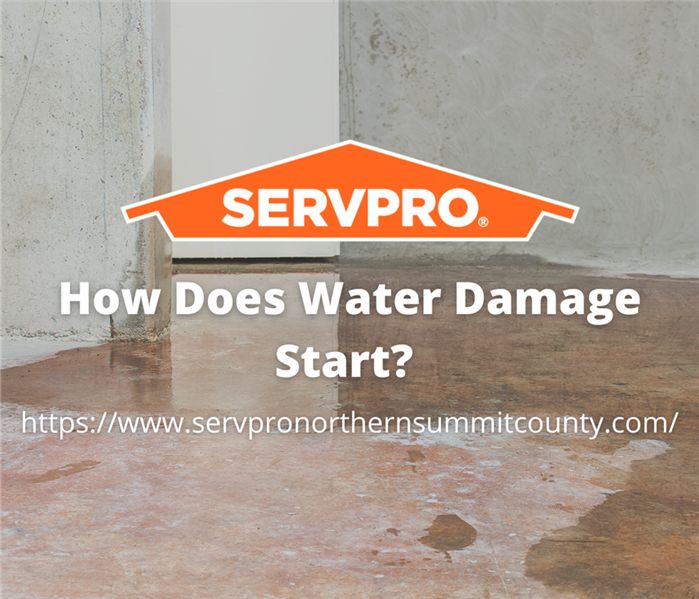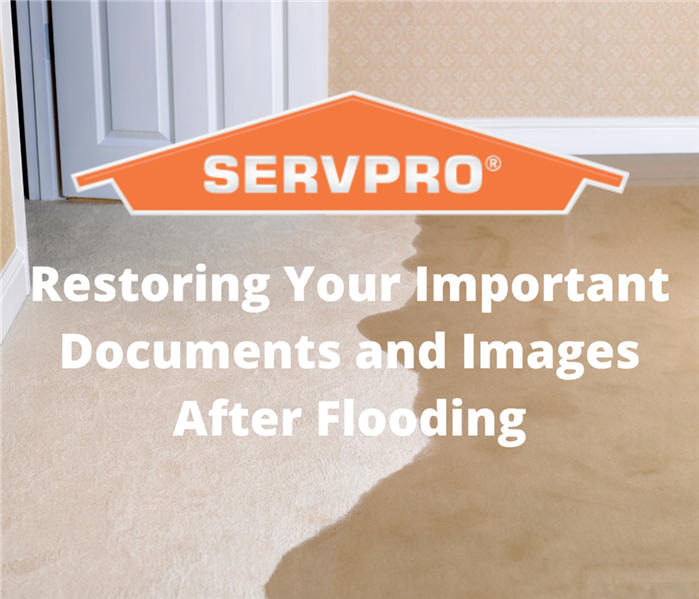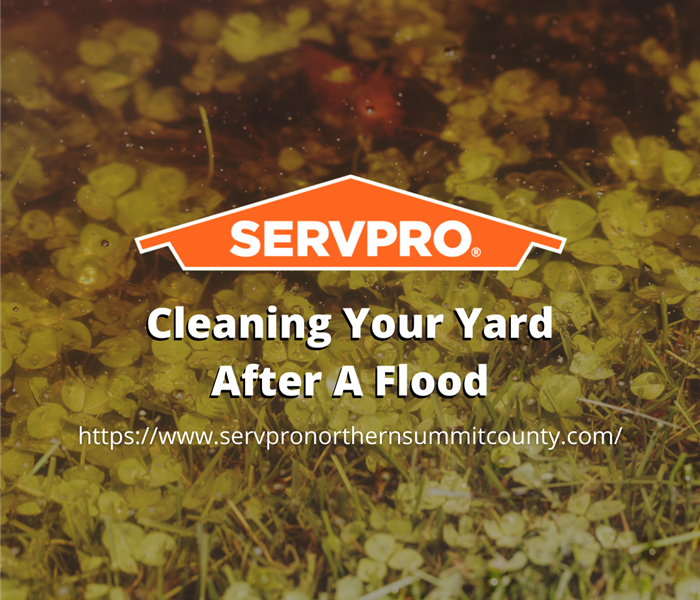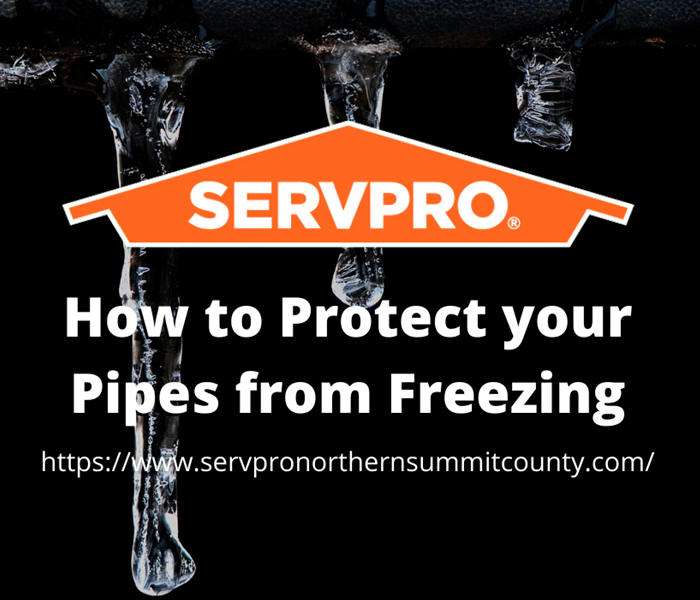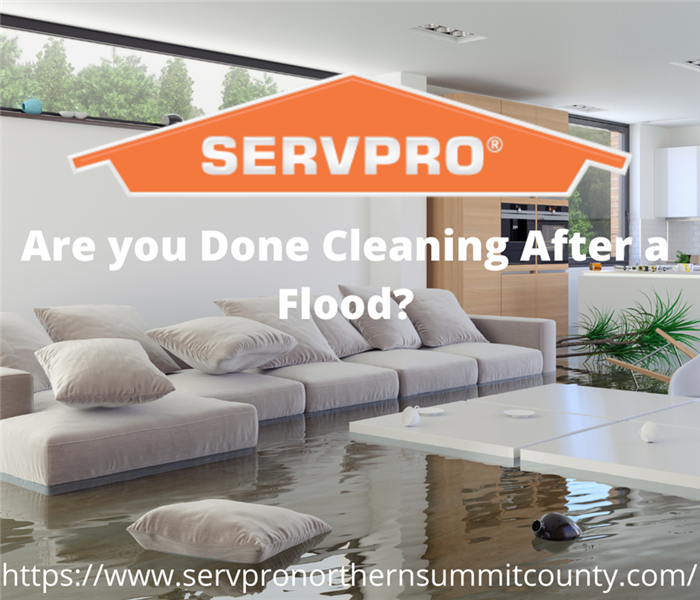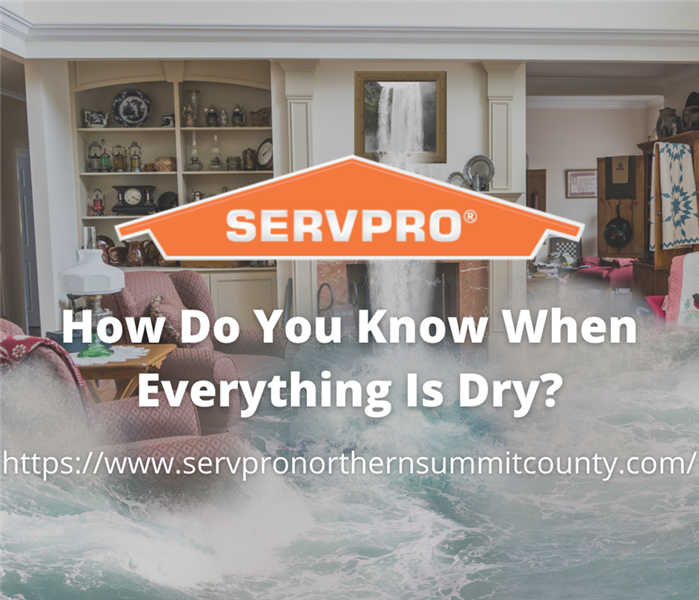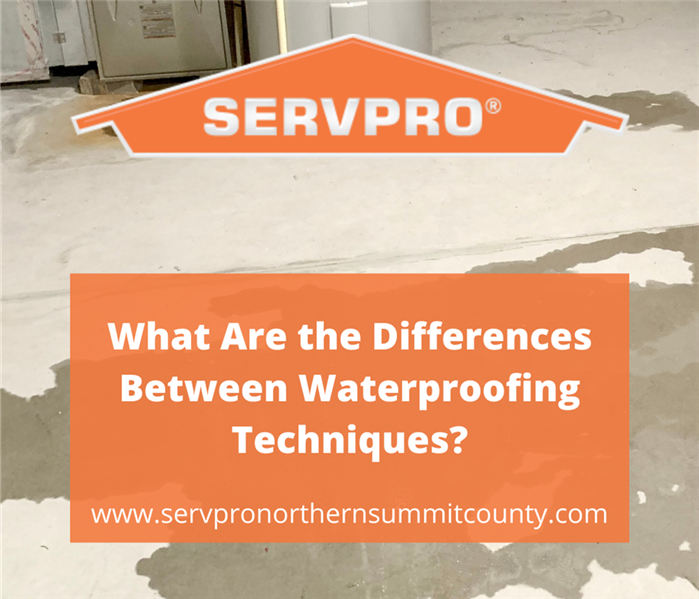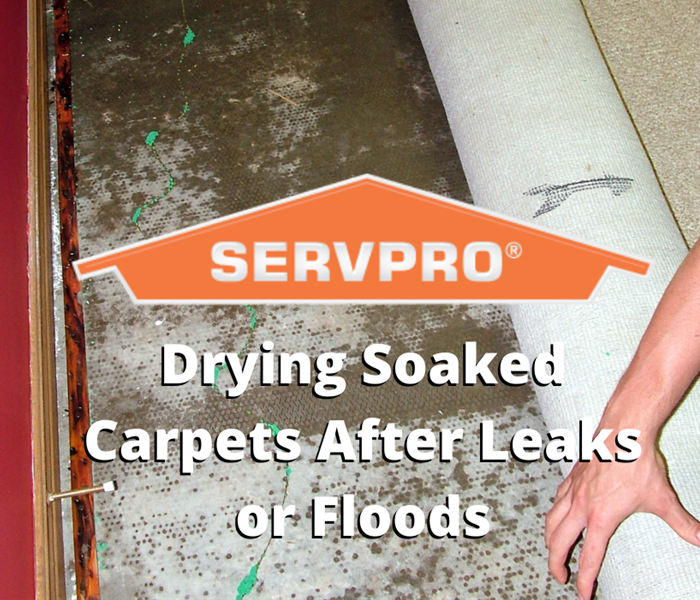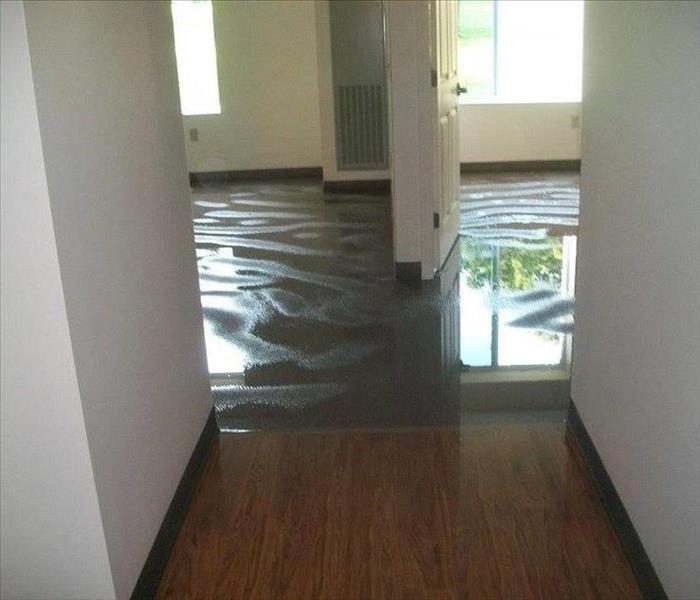Recent Water Damage Posts
How Well Does Cleaning Mold from Carpet Work?
7/24/2023 (Permalink)
Does Cleaning Mold From Carpet Work?
Carpets can get rid easily from water loss, or damage, sparks a bit of controversy. One factor to keep in mind is that unless mold is appropriately removed, the restoration contractor has failed in bringing the structure back to its preloss state. Without removing visible fungus colonies, a risk of sickness remains.
Let’s Set the Scene
Wonder Makers Environmental recently called their local Kalamazoo, MI SERVPRO, one of our sister franchises, to help in the cleanup of a building one of their clients own. Fungus had grown between their monthly checks, and at an impressive rate. A trail of clues led to the culprit: a malfunctioning water heater. Despite the checks, conditions suggested the water heater had been leaking for weeks. The question then becomes, how do you effectively restore the building, clean and dry the carpets, and remove the fungus that had grown exorbitantly? Getting rid of the fungus without the possibility of it spreading or returning, and not placing a health risk to anyone now or in the future due to the water damage is a job that SERVPRO takes seriously.
Delivering Results
Using a HEPA air scrubber, SERVPRO technicians were able to collect airborne spores that may be released by the hot water extraction process and to allow for air movement to speed up the drying of the carpet. After the workers completed their cleaning and restoration measures, Wonder Makers Environmental proceeded to run extensive testing on samples of carpet and air to determine the effectiveness of the remediation operation. The results were in: both air and surface samples were equally impressive. Spores per cubic feet were reduced from over 6,000 to less than 50. For more in-depth information, check out this article. Our work speaks for itself, even in a single case study.
How Does Water Damage Start?
7/25/2022 (Permalink)
Water damage can happen quickly and be difficult to stop. There are a number of events that can get water into your home, which will often lead to water damage. Knowing the reasons water damage starts may help you stop it before the damage is too harsh.
Flooding
Any type of flood can lead to water damage. Floods can leave you with standing water, which will inevitably lead to water damage. If possible, get rid of the standing water as quickly as possible.
Storms
Heavy downfalls of water can also cause water damage. If you have a leaky window or roof, water can get inside of your home, leading to damage. This is especially harmful if the water collects in puddles, as that makes it more difficult to get rid of.
Plumbing
Faulty plumbing is another culprit of water damage. Leaky pipes can lead to a buildup of water, which will ultimately lead to some form of water damage. Inspecting your pipes regularly may help you catch leaks before they become a problem.
Water damage can leave lasting effects on your home, so it is important to take action when you notice it. Hiring a damage restoration specialist will ensure a proper cleanup is completed for your home. If you ever find yourself in need of help cleaning up water damage, contact SERVPRO, faster to any disaster.
Restoring Your Important Documents and Images After Flooding
2/2/2022 (Permalink)
When you notice a flood in your home, it may be too late or dangerous to remove any important documents or pictures from the water. Water damage is not only bad for your flooring and foundation, but can ruin anything that is in the path of the water. Here are some ways SERVPRO cleans your precisions belongings:
- Air Drying
- Dehumidification
- Freezer Drying
- Vacuum Freeze Drying
- Vacuum Thermal Drying
There is no set schedule to flooding so it may be worth your time to buy water and fireproof safe to place all your important documents, pictures, and money in just to be safe. SERVPRO also offers Contents Claim Inventory Service where we will go all throughout your home to take note of any belongings or structures that were damaged by the flood.
Our Contents Claim Inventory Service:
- Preloss list and value of contents
- A detailed and accurate report
- Better information to settle claims quicker
- Assistance with the burden of proof for claims
- Peace of mind when you need it most
Cleaning Your Yard After A Flood
2/2/2022 (Permalink)
While there are endless amounts of information about what to do when your house floods, what do you do when your yard is flooded? As always, SERVPRO is here to help with some tips on how to take care of your lawn after a flood.
The first and most important thing you can do is avoid floodwater. Pools of water in your lawn can quickly become dangerous between the depth and unsanitary water. It’s best to hire a professional to inspect the water before attempting to remove it, yourself.
The next thing you should do is clean up debris. In many cases, a flooded lawn is caused by a particularly bad storm. This means that in addition to water, there will likely be branches or items from your neighborhood strewn around your yard. It’s also important to keep an eye out for sections of trees that have been damaged and hire a professional to remove them before they become dangerous.
You may also want to consider contacting a professional landscaper once the water and branches have been removed. This is the best way to have the highest chance of saving your beloved flowers, shrubs, and bushes after a flood has occurred.
How to Protect your Pipes from Freezing
2/2/2022 (Permalink)
With the winter season comes the possibility of frozen pipes. This can be a big issue, however, it can also be prevented. When one's pipes freeze it is likely they will burst which can be dangerous and damaging to a home. Here are some signs to look out for and ways to stop your pipes from freezing!
Preventing Frozen Pipes
Pipe freezing can cause devastating, costly damage by bursting or cracking. It is better to just avoid the situation altogether. There are many different things that can be done to help this issue:
-Insulate Pipes: The more insulation one uses, the better protected your pipes are. It is especially important to insulate in your home’s crawl spaces/attics because those are the areas where freezing is the most likely to occur.
-Seal Cracks: Locate any cracks in your pipes that let cold air inside. It is important to immediately take action and seal them to prevent further damage. You should look for any air leaks that may be happening around wiring or vents to be safe.
-Secure Outdoor Pipes: Before the cold/winter hits, garden hoses should be disconnected. Valves leading outdoors should also be drained. You can protect them by using facet covers in the winter months.
-Drip Warm Water: When you know that cold weather is coming it is smart to have a slow drip of warm water throughout your faucets to prevent them from freezing. This is especially important overnight when they aren’t being used.
-Adjust Thermostat: Try and keep the thermostat at a constant temperature to help prevent freezing throughout the day and night when there is cold weather. This will help keep the pipes warmer so they have less of a chance of freezing.
What To Do If Pipes Freeze
Pipes freezing can be a serious danger and action should be taken ASAP! If you turn on a faucet and there is only a drip or no water at all, it’s likely your pipes are frozen. Here are some steps to take if this is happening:
-Check Water Supply Lines: Go through and check the water supply lines and note any areas/spots that seem to be extremely cold. Be sure to notice any line breaks that there may be as well.
-Call a Professional: It is always a smart decision to call a professional when you are unsure of what to do. Protecting your home safely is a priority that a professional can help ensure. Get the help you need to prevent any unwanted damage.
-Shut off Water: If pipes have already burst or are about to turn off the water using the main water valve in your home. Be sure everyone in the home knows the location of this valve to prevent any costly confusion that could happen in the future.
-Use a Hairdryer: A hairdryer could be an at-home solution for a frozen pipe. You may be able to thaw the ice using the heat from the hairdryer. It is important, however, to check that there is no standing water that could lead to one getting electrocuted. Put your safety first!
Check your pipes this winter season to make sure they don’t freeze! SERVPRO is here to help prevent the damage from happening as well as clean up any that might’ve already happened. We want to help ensure the protection of you and your home. Don’t freeze in the possibility of danger!
How do you Know You're Done Cleaning After a Flood?
11/1/2021 (Permalink)
After a home flooding, it can be a great relief to see the water removed and your home begin to dry out. But just because the water is out, doesn’t mean your home is safe.
The biggest problem that arises from flooding is mold. Under the perfect circumstances, mold can begin to grow just 24 to 48 hours after flooding. And even after standing water is removed, there is still the risk of excess moisture.
So how do you deal with moisture that could cause a mold outbreak? The first step is to get rid of any materials that were soaked and cannot be properly cleaned or will not dry thoroughly. Carpet and carpet padding must be torn out and trashed. Padded and cloth-covered furniture like loveseats and couches may need to be tossed as well.
Drywall should be removed 12 inches above the waterline. Most baseboards will also need to be discarded. If the insulation behind the drywall is wet, cut it above the wet area and discard it. Don’t pull the entire column of insulation down, as it can be difficult and expensive to replace.
Once the compromised materials are removed, you can focus on the floors and studs. In most cases, floor boards and studs can be saved, but they must be cleaned and dried properly. To do so, ventilate your home by opening windows and allowing for air circulation. To help air flow, use simple box fans or even carpet dryers. If you’re not able to open windows, use a dehumidifier. Even after you think the space is dry, continue the drying and ventilating process.
We also recommend using a moisture meter, which can read the moisture level in the floorboards and studs. Once these materials are at or below 16% moisture, you are safe from future mold growth.
How Do You Know When Everything Is Dry?
10/4/2021 (Permalink)
After you’ve had a flood in your home, your first question during the restoration process may be, “How will I know when everything is completely dry?” You may even be wondering if everything in your home ever will be completely dry again.
One of the easiest ways to be sure that everything will be dry is to hire professionals, such as our SERVPRO professionals, to handle the restoration process for you. At SERVPRO, our technicians have professional equipment that can help us to know when your property is dry:
- Moisture Sensors: detect moisture in carpets, baseboards, and walls.
- Moisture Meters: determine the moisture content of various materials.
- Thermohygrometers: measure both temperature and relative humidity, allowing SERVPRO professionals to calculate humidity, dew point, and vapor pressure in your property.
In general, it can take several weeks to completely dry out a house and its contents. If you have the ability to set your belongings outside to dry, it’s usually best to do so. Fabric items such as clothes, towels, or bedding can typically dry within 24 hours if left outside, as long as the weather permits. Remember to avoid placing items in direct sunlight if you use this method. As for larger items, such as mattresses or furniture, it could take up to a week to dry them outside, so we recommend hiring a team of professionals to ensure that your possessions are dried quickly enough to avoid mold growth.
What Are the Differences Between Waterproofing Techniques?
9/5/2021 (Permalink)
When it comes to keeping your basement dry, there are many ways that any homeowner can stay proactive and on top of things. While sometimes the fixes may be smaller like a dehumidifier or sealing cracks, there are other instances that will require a little more time and attention. Waterproofing your basement, in particular, is one step that will take more effort, but is probably unavoidable.
The good news is, there is more than one way to waterproof your basement.
Oftentimes the word itself can be intimidating because everyone thinks it is expensive. However, depending on your needs, you may be able to settle for a different waterproofing technique. Additionally, depending on how bad the water intrusion is you may be able to do some patchwork. But, when it comes down to waterproofing, there are two proven methods. So, what are your options?
Interior:
When you choose to do an interior waterproofing job, it will be more cost-effective. Your basement concrete walls will be deconstructed and rebuilt with a proper drainage system. This will require installing a sump pump as well. Although this method may be the less expensive route, it may not have as long of a lifespan.
Exterior:
Choosing to go with exterior waterproofing is likely to be a little more costly, but an investment in your home. With this method, the company will dig around the perimeter of your home to basically reinforce your drainage system and add an extra layer of protection. Because this option requires digging, it can only be done when the ground is not frozen.
Although one option may stick out to you more, every situation is unique. If your home is going to be your forever home it may be best to invest in protecting your basement.
If your waterproofing needs are not as extensive, you may be able to get away with an interior waterproofing job. If your basement is showing signs of mold and water damage, you should get in contact with your local contractor. They will be able to help you decide what option will best suit your needs, and your local SERVPRO can help to get rid of that mold and water in no time!
Regular Checks for Homeowners on Plumbing and Pipes
7/8/2021 (Permalink)
When it comes to home maintenance and spring cleaning the list can be endless, but still, everyone usually has the basics: rake the leaves, weed, clean the gutters, mow the lawn, etc. Although these are crucial tasks to have on your list, you may be forgetting a few important items like checking pipes and plumbing.
That old saying “out of sight out of mind” is not always a good thing. Even though you can’t see all of the pipes and plumbing in your home, they still need a little TLC. So with that being said, what should you check for?
Faucets
Once a quarter or a few times a year (at least) it is a good idea to check all of your faucets and spouts for water drips. Sometimes all you will need to do is tighten a few nuts and bolts. Not only will it be nice to not hear dripping water, but it can also save you money on your water bill - those leaky faucets add up.
Outdoor Water Spouts
You should check your outdoor water hookups regularly as well. It is also important to shut off the outdoor water valve in the winter to avoid frozen pipes and damage.
Running Toilets
If you have a toilet that is prone to running, you may be able to do an easy fix. Sometimes it just requires a small part that can be picked up at your local hardware store - again it will be budget-friendly for your water bill.
Drainage
Whether it is your shower or your sink, it is important to make sure everything is draining properly and that they are well sealed. If you notice extra mold or mildew (smell or see) you may have some water leakage. Not only is this going to be important for the lifespan of your shower/sink/plumbing, but it will also be important for your health.
So now that you have a list of a few different plumbing and pipes that should be checked and maintained regularly, you can get to work. If you find an area that has been neglected or is particularly mold-ridden, give SERVPRO a call for expert mold mitigation.
Best Methods to Dry Soaked Carpets After Leaks or Floods
2/26/2021 (Permalink)
Floods and leaks are a hazard, and many people don’t like them. But what about your carpet? How does the carpet feel about leaks and floods? The answer is, not super great. Wetness on carpets can create long term damage to carpets or even make them irreparable. When a carpet is exposed to large amounts of water, it is best to start drying your carpet immediately.
But how should you dry a carpet? Here are the steps:
- Remove all the furniture
This will make it easier to remove the water without any obstructions. When the carpet is finally dry, and the furniture has been sitting on it, it will leave dents and ruin the carpet’s volume.
- Pump out the water
Removing as much water as possible is a priority. Using a submersible pump is best; you can rent one from a nearby hardware store. If you cannot rent one, using a bucket is the next best option.
- Use a shop vac
The excess water by now should have soaked into the carpet, and the best way to remove it is through a shop vac. DO NOT use a household vacuum cleaner; it is not made for cleaning out water and poses a high chance of electrocution.
- Use a dehumidifier
This will help in the case of extracting more moisture from the room.
- Dry the carpet
- Turn on fans
- Use towels
- Open windows
- Turn on the air conditioning or heat
- Remove the padding
This is when the possibility of the padding and subfloor could have been damaged. If water has reached it, it is a better and cheaper option to just to replace the padding
- Dry the subfloor
Use fans to dry any water that has reached the subfloor. Once dry, add more filling and place the almost dry carpet back.
- Clean the carpet
Once the carpet is damp, clean it. Use a carpet cleaner or cleaning solution. This will remove any bacteria or dirt.
Steps to Prevent Frozen Water Damage
2/4/2021 (Permalink)
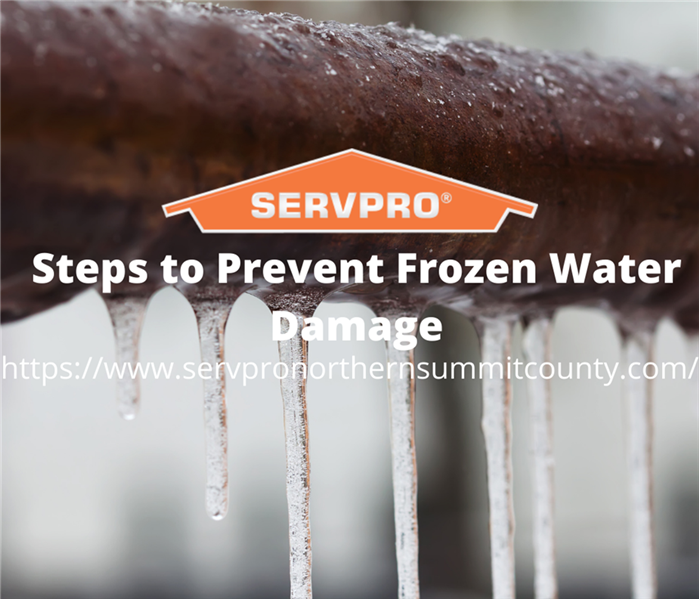 Avoid water damage to your home and plumbing.
Avoid water damage to your home and plumbing.
As the days get colder, you start adding gloves, hats, coats, and scarves to your wardrobe to prepare and protect yourself from the harsh weather outside. Your home needs the same kind of care to prepare for the colder weather as well. Taking precautions before freezing temperatures hit can help save you a lot of money and stress later when you don’t have to deal with a burst water pipe in the dead of winter or other water damage that can occur.
Clean Your Gutters
Now that fall is in full swing and the leaves have fallen, clean out your gutters to prepare for winter. Clogged gutters can cause water to back up and freeze which in turn will cause water to leak into your home and wreak havoc. It is also important to knock off any large icicles.
Prepare for Winterization
The process of winterizing plumbing pipes prepares the home for freezing temperatures that can cause leaks and breaks in the home. When water freezes it expands and if the expansion occurs in pipes it can produce pressure and cause damage. This process is recommended when the home will be vacant and no water will be running through the pipes. Make a plan when beginning this process as well as a list of all your home’s plumbing parts and you can be sure not to miss a step.
Steps to Winterize Plumbing
- Shut off the main water valve and turn off the water pump and heater
- Open all drain valves and taps
- Blow excess water out of pipes using an air compressor
- Open the drain valve in your hot water tank and let it drain completely
- Flush all toilets repeatedly to remove as much water as possible and add antifreeze.
- Check all sinks and tub drains for drain traps, add antifreeze to any found.
Taking the time to follow these steps can save you a lot of time and money in costly repairs later. For more information and tips be sure to call SERVPRO of Northern Summit County and they can walk you through the process.
What You Need to Know About Hard Water Softeners
1/28/2021 (Permalink)
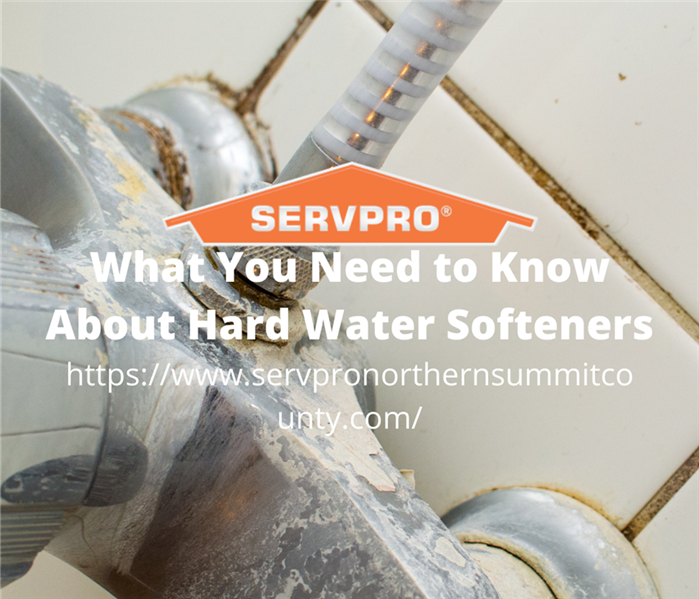 Learn about the benefits of water softeners for your home and business.
Learn about the benefits of water softeners for your home and business.
YOU know if you live in a hard water area – your sinks and faucets discolor, your hot drinks have white flakes in them, and you are covered in a film every time you shower.
Luckily, there is nothing inherently dangerous about hard water for humans – it simply means your local water supply has a high level of calcium in it, which can basically come out of the water supply in your home and turn into little flakes of limestone.
Indeed, calcium is good for our bones – but hard water is no joke for our appliances and water system.
People who live with hard water tend to have to replace essential white goods like washing machines, dishwashers, ice makers, kettles, and even whole furnaces on a regular basis as the limestone builds up around heating elements and eventually effectively suffocates the equipment.
It can also build up inside pipes – especially hot water pipes – leading to reduced pressure and blockages.
There are many ways to remove limescale and treat appliances, but the most effective is to stop the problem at the source and install a water softener into your main supply, so the water is treated before it hits your home and appliances.
By running the hard water through a softener, a chemical reaction with salts takes place, removing the excess calcium, from the water and providing your home or offices with more softened water, and saving on your repair and replacement bulls in the future.
Dangers of Standing Water in a Home
11/20/2020 (Permalink)
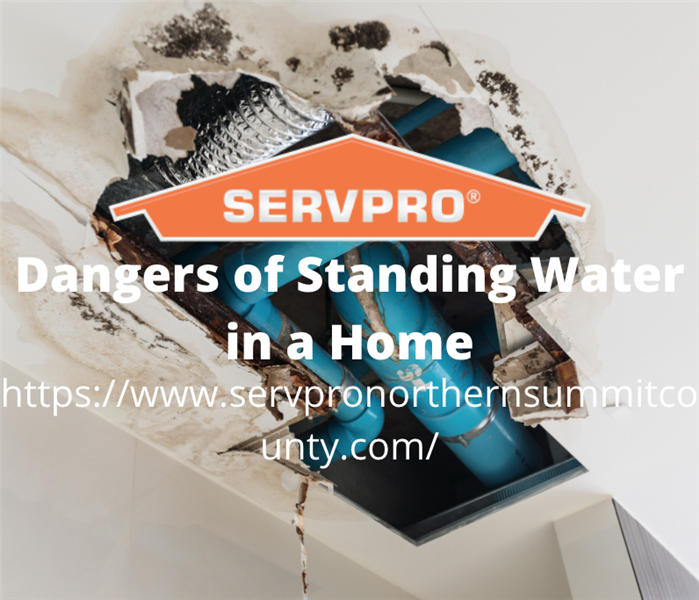 Prevent water damage in your home and business.
Prevent water damage in your home and business.
Whether it is your home or your business, preventing water damage and intrusion is crucial. When a hard rain hits, it won’t be hard to tell if you have sitting water in your basement, or near your foundation. However, oftentimes, water will intrude your home or business in spaces that you cannot see on your own. The good news is that when this happens there are usually a few red flags to look out for.
One telltale sign that you have hidden water damage is an unpleasant smell. Although the water may be invisible, the smell of mildew is not. If you begin to smell this in your home or business it is likely that there is also fungus growing somewhere. In a situation like this, not only is it bad for the foundation of your home or business, but it can also cause health issues.
If you start to notice that musty smell, it is a good idea to begin to keep an eye out for visual signs of water damage. In addition to being able to see mold growing on your walls, you may notice a stain. And, while discoloration may not seem like a big deal, chances are that it is only the beginning of your troubles. As the damage gets worse you may begin to see sagging ceilings and walls, as well as peeling paint.
Once you know what to keep an eye out for, it is easier to recognize if you have water damage. Taking care of the problem sooner rather than later can help to prevent further issues including safety hazards, structural issues, and health problems. If you notice any of these signs in your home or business, you should contact a professional right away so that you can find the source of the water invasion. For an advanced water inspection by a highly trained water restoration technician, give SERVPRO a call today.
Avoid Fall Property Damage in Northern Summit County
10/21/2020 (Permalink)
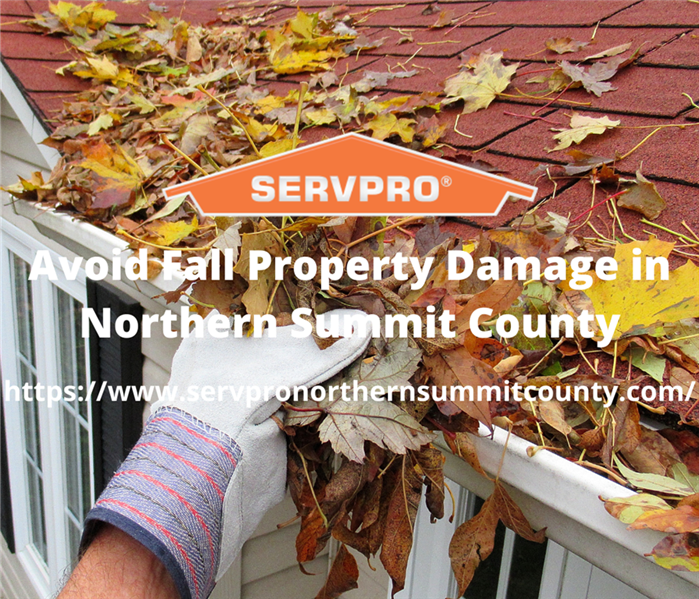 Do a little maintenance around your home now and avoid disaster later.
Do a little maintenance around your home now and avoid disaster later.
Spring is the season with the most rain, so it only makes sense that it would be the season that results in the most water damage at properties, right? Well actually, water damage property claims go up by about 30% in the fall and early winter. Fall storms can wreak just as much havoc as any other time of the year, and often even moreso because we aren’t prepared for the bad weather
Rain itself isn’t usually the main culprit that causes damage and disaster, it’s the lack of preparation or issues with maintenance that typically result in big issues. For instance, when heavy rains come in the fall, or even mild rains, that water is competing with debris as it tries to move away from your home. Your gutters, for instance, can easily become clogged with all of the falling leaves and if water can’t move away from your home it might end up inside of it. Additionally, if the gradient around your home isn’t sloping down and away from your home, it could mean that water is collecting around your foundation and seeping into your home.
Another common fall problem is frozen and burst pipes. It is very important that you winterize and outdoor faucets or spigots to make sure that they don’t freeze with the sudden temperature drops. Of course, the fall is typically mild until late November or so but you can never predict when the temperature might plummet to freezing, causing snow and ice. Make sure that any vulnerable pipes that are exposed to the elements are properly insulated to prevent freezing and bursting. You should also make sure to keep your thermostat set to at least 55 degrees or higher to make sure that you are maintaining enough warmth in your home to prevent dips that can cause freezing.
You should always take whatever steps you can to ensure that your property is safe from damage, but if the worst happens to you, you can count on SERVPRO of Northern Summit County to have your back. We are faster to any disaster.
Plumbing Problems in Your Northern Summit County Home
9/26/2020 (Permalink)
 Don't let leaky pipes and other plumbing problems cause issues in your home!
Don't let leaky pipes and other plumbing problems cause issues in your home!
WATER is a powerful and relentless force of nature – as well as being essential to our everyday lives, it can also cause a lot of damage.
We cannot live our daily lives without using the miracle of running water in our homes – a shower to start the day, tap running to clean our teeth, water for the coffee machine in the kitchen, set the dishwasher running as we head to work, throw a laundry load in when we get back, and of course flushing the toilet a few times.
But when water comes out of our plumbing system in a place you do not want it to, you have big problems on your hands – water will simply keep coming 24 hours a day until the problem is fixed, whether it is a high-pressure burst or a slow but continual drip - drip - drip.
And it will always take the path of least resistance – working its way through units, downpipes, along floor joists, through the floorboards until it cannot go any further when it will start pooling and backing up.
Flooding damage is expensive – it will ruin not just carpets and floors but soak into the drywall like a sponge meaning extensive and expensive repairs.
And if it is your foul water pipes that have been compromised, dealing with sewage could increase damage exponentially.
The top ten most common plumbing problems are: dripping taps, slow draining sink, clogged bath drain, a clogged toilet, running toilet, faulty water heater, low water pressure, jammed garbage disposal, leaky pipes, and a sewer system backup.
If you are unlucky enough to suffer a flooding disaster, it is vital to act quickly to minimize the impact of the damage – damp fixtures and fittings soon become moldy ones too. SERVPRO of Northern Summit County is on hand 24/7 to help you clean up and then restore your home to the way it should be.
How to Test Your Sump Pump Before a Storm
7/17/2020 (Permalink)
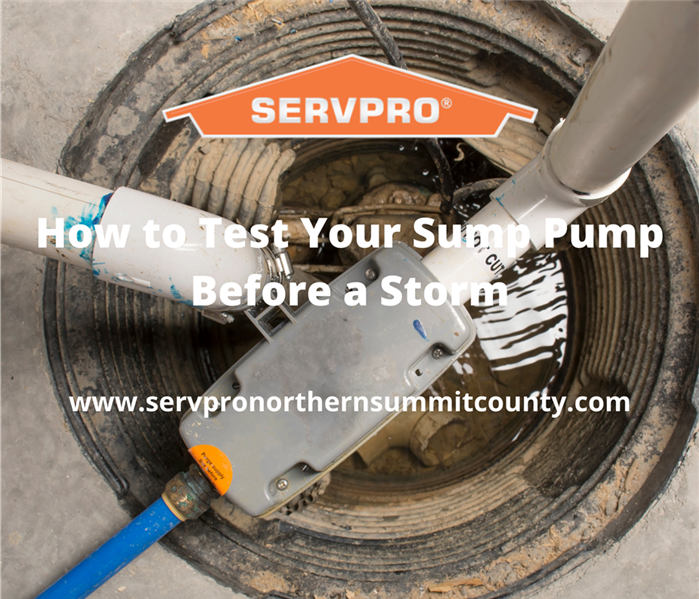 You can avoid big problems with just a little bit of maintenance.
You can avoid big problems with just a little bit of maintenance.
A sump pump in your home could mean the difference between an average day and a disaster. Sump pumps are meant to remove excess water from around the foundation of your home – something that could prove to be invaluable during a major storm. It’s important, however, to periodically ensure that your sump pump is working properly. Regular testing will keep you apprised of any issues with your sump pump that need to be addressed before it’s too late and your home is flooded.
Testing is fairly simple and doesn’t require any special skills.
- First, you want to identify the exit pipe that drains water out of your home (it will be located outside the house). Inspect the pipe for any debris that could be clogging it to ensure that it will drain properly.
- Next, you should take a large bucket of water and slowly pour it into the sump pit until you hear the pump click on and start draining the water.
- Listen as the water recedes to hear the pump click back off once the water has been drained.
If the pump either does not kick on when water is poured into the pit or if it doesn’t shut off again once the water has been drained, it is not working properly. Most commonly, sump pumps get unplugged by a member of the family for one reason or another and then forgotten to be plugged back in. This incredibly simple solution could make a significant difference in the event of a high water situation. Another common sump pump problem is that the float activator is set too high and doesn’t turn the pump on in time. You can adjust it yourself fairly simply and ensure the pump kicks on when it is supposed to. If you check all of the above aspects but the pump still doesn’t work, then you know that it is time to have it professionally serviced.
Performing regular checks on your sump pump could be the difference between a dry home and a house flood that will disrupt your life. If you experience water damage in your home, call on us at SERVPRO of Northern Summit County to come to the rescue. We are faster to any disaster at any time, 24/7/365. You know you can trust our highly qualified technicians to help make it "Like it never even happened."
Six Ways to Protect Your Home From Flooding
2/2/2020 (Permalink)
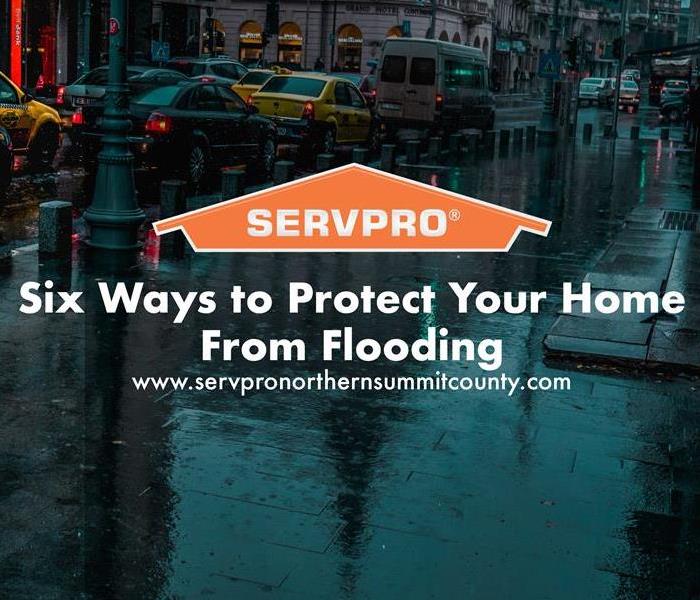 SERVPRO of Northern Summit County has the expertise and the resources to handle water damage in your home.
SERVPRO of Northern Summit County has the expertise and the resources to handle water damage in your home.
Six Ways to Protect Your Home From Flooding
Flooding can strike anywhere at anytime. Floods are a common and expensive natural disaster in the U.S. If you ignore this risk, you could be left with a destroyed home and belongings. It is hard to prevent flooding, but by taking little precautions and actions you help avoid major damage from a potential flood. The first step in avoiding a flooding risk is knowing the flood level of your home with an official measure of how high floodwaters could rise.
Your next steps in protecting your home from flooding should include the following:
- Make sure to raise switches, sockets, circuit breakers and wiring at least a foot above the expected flood level.
- Fuel tanks, air-conditioning units and generators should be anchored above your flood level as well.
- A flooded sewer system can cause sewage to back up in your home, so you will want to install an interior or exterior back-flow valve.
- The grading or slope of the house can direct water either way from your house. This can be determined by watching how water flows.
- If your home floods frequently you can raise your home on piers or columns so the lowest floor is above flood level.
- Make sure to have clear gutters, drains and downspouts. You will also want to move furniture, rugs, electronics and other belongings to upper floors when flooding will not happen.
Bonus tip, you will want to shut off electricity at the breaker panel with any sign of flooding. If flooding increases you will want to elevate major appliances onto concrete blocks if they're in harm's way.
SERVPRO of Northern Summit County has the expertise and the resources to handle water damage in your home. If you need assistance call (330) 650-4486
Freezing Temperatures In Northern Summit County Can Cause Winter Water Damage.
12/22/2019 (Permalink)
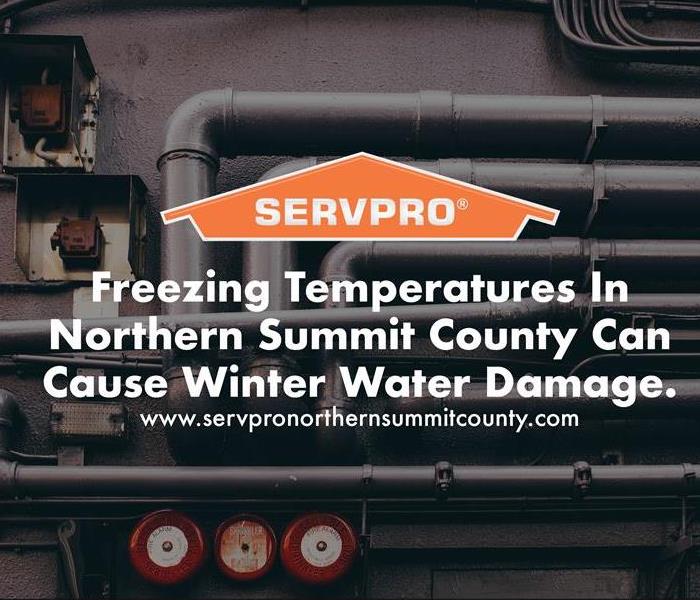 SERVPRO of Northern Summit County has the expertise and the resources to handle your winter water disaster.
SERVPRO of Northern Summit County has the expertise and the resources to handle your winter water disaster.
Northern Summit County is notorious for winter and this years winter is no exception. We are all aware of the downsides of unpredictable winter weather that might affect our homes. It is important to be proactive as much as you can in the winter months.
Winter temperatures can vary greatly from day to day in Northern Summit County. We sometimes see those warm days turn quickly to bitter cold ones. The sub-zero temperatures can be dangerous to our homes.
Pipes within the exterior walls are vulnerable. Water within pipes may become cold enough to freeze. Water expands when it freezes, and it has nowhere to go, therefore it can cause pipes to burst. Water can flow into walls and onto floors, causing flooding and damage.
Cold temperatures and freezing water can do damage on the outside of the house. An ice dam can form along the edge of your roof or even along the gutters. This happens when a higher temperature section of the roof is above freezing yet the lower part is below freezing. The ice forms a barrier which blocks the flow of water off the roof. The hard ice will push the shingles out of place and allow water to slip down to the ceiling or attic. Water damage will continue until the ice dam is discovered and the affected area is repaired. This is why it is so important to make sure your home is properly insulated.
SERVPRO of Northern Summit County has the expertise and the resources to handle your winter water disaster. If you need assistance call (330) 650-4486
Tips For Water Damage
12/1/2019 (Permalink)
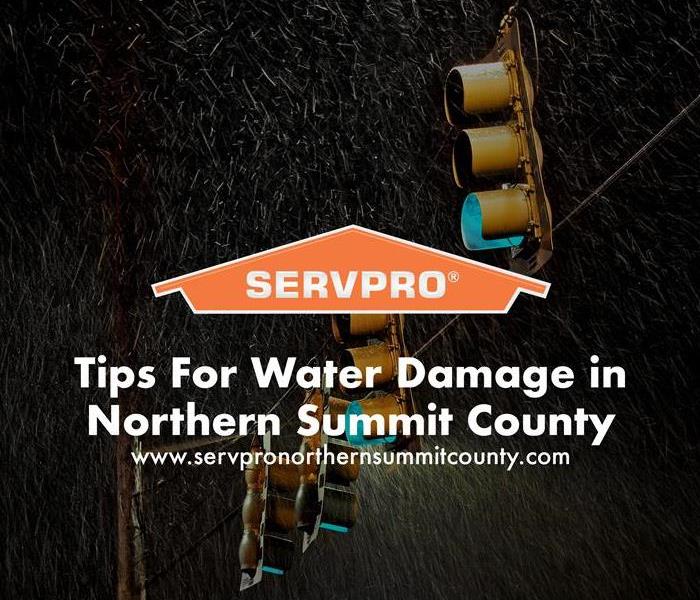 The period after a large storm or flood is often a hectic. While waiting for SERVPRO to arrive to perform water damage restoration.
The period after a large storm or flood is often a hectic. While waiting for SERVPRO to arrive to perform water damage restoration.
The period after a large storm or flood is often a hectic. While waiting for SERVPRO to arrive to perform water damage restoration there are some simple do and don’ts.
You can take great steps to avoid further property damage in your wet basement or other areas of your home:
DO
- Shut off the source of water if possible or contact a qualified party
- Turn off circuit breakers for wet areas of the building when access to the power distribution panel is safe from electrical shock.
- Remove as much excess water as possible by mopping.
- Wipe excess water from wood furniture after removing lamps and tabletop items.
- Remove & prop up wet upholstery cushions for even drying.
- Remove to a safe, dry place any paintings, art objects, computers, and documents.
DON’T - Enter rooms with standing water where electrical hazards may exist.
- Enter affected areas if electrical outlets, switches, circuit breakers or electrical equipment are exposed to water.
- Leave books, newspapers, magazines or other colored items on wet carpets or floors to cause staining.
- Leave Oriental rugs or other colored rugs on wet wall-to-wall carpets to cause staining.
- Use your household vacuum cleaner to remove water, possibly causing electrical shock or damage to the vacuum cleaner.
- Use TV’s or other appliances while standing on wet carpets or floors, especially not on wet concrete floors
Remain calm, help is on the way.
SERVPRO of Northern Summit County has the expertise and the resources to handle any size disaster. If you need assistance with storm or flooding call (330) 650-4486
Winter Causes Water Damage in Northern Summit County
11/4/2019 (Permalink)
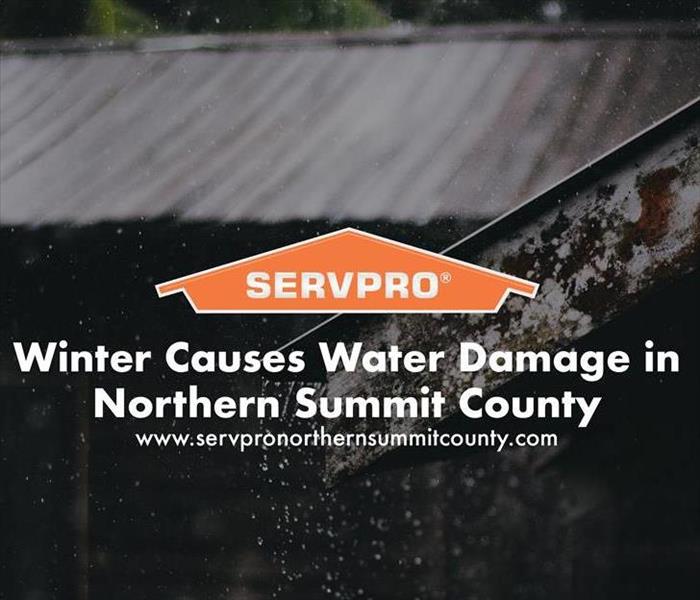 SERVPRO of Northern Summit County has the expertise and the resources to handle any size disaster.
SERVPRO of Northern Summit County has the expertise and the resources to handle any size disaster.
Water damage may occur at any time of year, cold temperatures and inclement weather can combine to trigger winter water damage. This can be leaks and water intrusion in Northern Summit County. To reduce seasonal risks, be aware of these common sources of water damage in the winter months:
- Frozen Pipes
Install pipe insulation on all supply pipes potentially exposed to freezing temperatures. This can be the crawl space or up in the attic. When a hard freeze is in the forecast, open faucets slightly and allow them to drip to relieve pressure if pipes freeze. If water flow stops during extreme cold, assume a pipe has frozen. Don’t wait until it thaws to find out there’s a rupture, get help immediately. - Ice Dams: Water runs down to the colder portion of the roof then freezes again, obstructing flow of runoff into gutters. Water then seeps through shingles and sub-roofing and causes water damage in the attic. You can prevent this by making sure the attic is properly ventilated to remain uniformly cold. Make sure to seal ceiling cracks, gaps and other openings with caulking to prevent heat loss into the attic.
- Snow Melt: Melting snow around your house can saturate deep into the soil and leak through the foundation and basement walls. Shovel accumulated snow away from the house. If you can, seal cracks and gaps in the basement wall and, if you don’t have one, install a sump pump.
It’s cold outside! Knowing the types of winter water damage that can occur can help you avoid these hazards.
SERVPRO of Northern Summit County has the expertise and the resources to handle any size disaster. If you need assistance with storm or flooding call (330) 650-4486
What To Do If You Have Water Damage
9/28/2019 (Permalink)
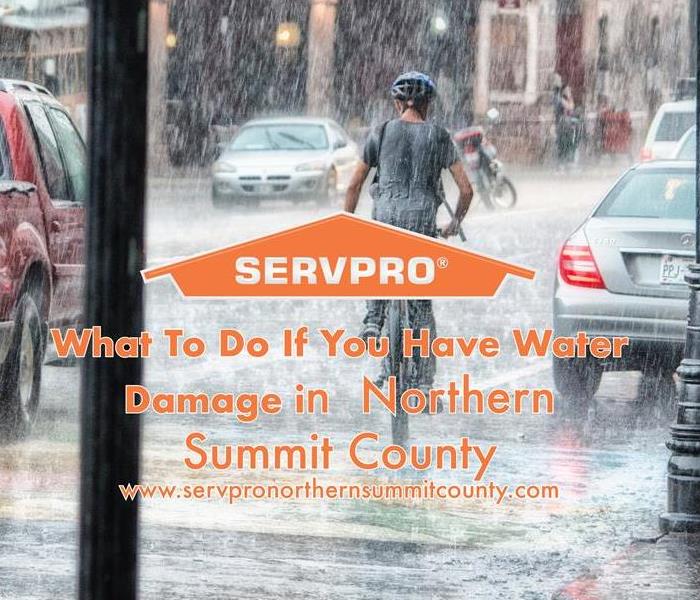 Call SERVPRO of Northern Summit County if you have water damage. If you need assistance with storm or flooding call 1-800-648-1212.
Call SERVPRO of Northern Summit County if you have water damage. If you need assistance with storm or flooding call 1-800-648-1212.
Water in unwanted places can cause a lot of damage. It can ruin your prized possessions and your home. If you have water damage it is important to act quick, call your insurance company then a restoration company like SERVPRO of Northern Summit County. Here are some tips for you to do until help arrives:
- Disconnect the power, unplug any electronics, and remove electronics, furniture and movable items immediately. The faster you get items out of the way, the more likely you’ll be able to save them. Definitely move all electrical items first, and if you can, turn off your power leading into the affected area, especially if water rises above electrical outlets.
- Get rid of the water. There are several ways to get rid of the water. As long as sewers in your neighborhood aren’t backed up, you can pour the water down the drain. A wet/dry vacuum can be used too. Be very careful to plug it into outlets far away from water. Don’t use an extension cord as the connection could also short out and give you a nasty shock; water and electricity don’t mix!
- Dry out the affected area. Make sure to mop up all the water, use fans and a dehumidifier to help dry out the area. Open windows to allow for air circulation and faster drying, if you are able.
- Disinfect. After the area has dried out, including wood beams, insulation, drywall, etc., use a good disinfectant to get rid of any bacteria that might have come up through sewers, toilets, etc.
- Dispose of damaged items responsibly: Don’t be tempted to throw everything into a dumpster. Organize damaged goods into piles and take what you can to recycling centers, you will help alleviate the pressure on your local landfill site.
Call SERVPRO of Northern Summit County if you have water damage. If you need assistance with storm or flooding call 1-800-648-1212.
SERVPRO of Northern Summit County uses structure materials with thermal imaging
8/27/2019 (Permalink)
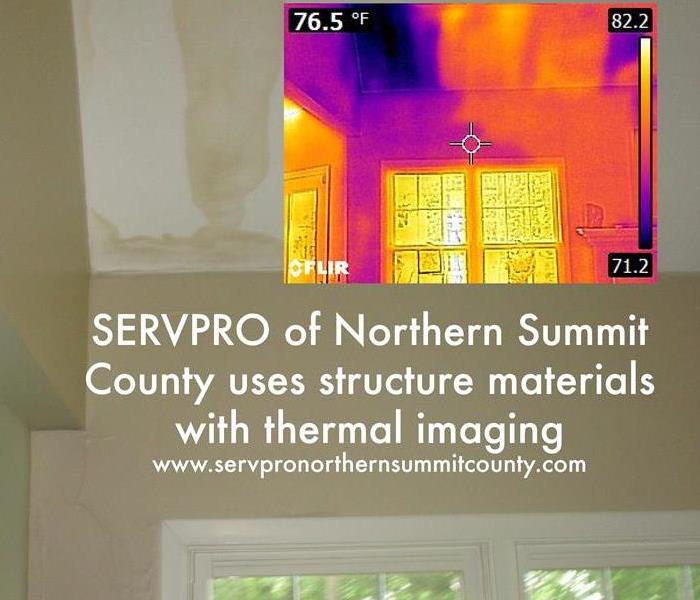 Thermal imaging is just one piece of technology services at SERVPRO of Northern Summit County used to utilizes water damage in your home.
Thermal imaging is just one piece of technology services at SERVPRO of Northern Summit County used to utilizes water damage in your home.
Structure materials with thermal imaging and standard camera are Red, yellow orange indicated dry and blues and purples indicate elevated moisture.
Using thermal imagers to detect moisture intrusion is a relatively new practice in water damage mitigation. Thermal imaging has be used successfully to detect water intrusion in interior walls following roof leaks, foundation failure, chimney leaks, etc. It can find things that the naked eye doesn’t always see. SERVPRO of Northern Summit County has this powerful equipment to help get your water damage taken care of.
There are a number of areas where moisture can accumulate that are frequently overlooked in typical inspections. Using thermal imaging technology can help reduce the cost to repairs by minimizing damage to the property to find the core source of water intrusion.
Thermal imaging is just one piece of technology services at SERVPRO of Northern Summit County used to utilizes water damage in your home. Contact us today to schedule a site inspection (330) 650-4486.
Ways You Can Prevent Water Damage in Northern Summit County
7/7/2019 (Permalink)
 If you need help with any water damage clean-up, don’t hesitate to call our extremely well-trained professionals at SERVPRO of Northern Summit County
If you need help with any water damage clean-up, don’t hesitate to call our extremely well-trained professionals at SERVPRO of Northern Summit County
When you own a home, maintaining can seem tedious and tiresome. However, that maintenance is one of the best ways to prevent water damage to your home. Consider it a way to avoid a more costly outcome as water damage ranks among the highest for cost and commonality for homeowner disasters.
What can be done to prevent water damage? Here’s a list to add for maintenance for a start:
- Proper Drainage: This step is vital. Poor drainage can lead to many issues such as cracks in your foundation, uneven settling, and allowing ways for water to seep into your home. Gutters and downspouts are included in this preventative measure. Clean them regularly to keep out leaves and other debris. Gutter guards can help if your gutters tend to clog easily and often.
- Inspections: The following areas should be inspected well and often; refrigerator, water heater, air conditioning unit, attic, hoses, faucets, sinks, showers, tubs, and toilets. All of these pieces may develop leaks or damage that needs to be taken care of before disaster strikes. Stay ahead of those by checking them to catch any danger before it starts or spreads.
- Installations: Some tools to install that may be beneficial are an emergency pressure release valve in plumbing system, water leak detection devices or alarms, a water flow monitoring system, and floor or drain pans. The latter helps with slow leaks while the others work as an extra set of eyes on your home in case of excess pressure, water flowing where it shouldn’t, and any leaks you may not have detected yet.
- Test, Check, and Fix: By testing your sump pump and checking your pipes, you will be on top of any leaks, cracks, or repairs that are necessary. If you get caught in a storm with your sump pump out of commission, you will be in a world of trouble. Fixing any issues right away avoids mold, mildew, dry rot, or any detrimental water damage problems.
While these are just a few of the measures you can take to prevent water damage from occurring, they remain important.
If you need help with any water damage clean-up, don’t hesitate to call our extremely well-trained professionals at SERVPRO of Northern Summit County to make it “Like it never even happened.” We are available for assistance 24 hours per day, 7 days a week including holidays and weekends.
What To Do When A Flood Hits in Summit County, Ohio
5/23/2019 (Permalink)
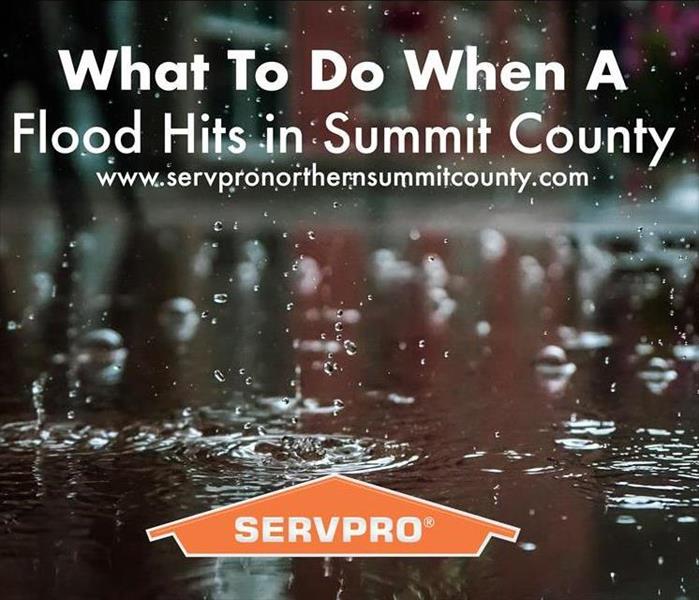 Flooding is a common natural disaster, and the aftermath can cost a pretty penny.
Flooding is a common natural disaster, and the aftermath can cost a pretty penny.
Flooding is a common natural disaster, and the aftermath can cost a pretty penny. Whether floods hit suddenly or more slowly, they can be dangerous and leave a mess in their wake. Don’t underestimate the power of flood waters.
Keep yourself and others safe by following some guidelines of what to do when a flood hits:
- Due Diligence: Check to see if you’re in a flood-prone area. Your local floodplain administrator should be able to help you determine this. Here is a list from the Ohio Dept. of Natural Resources, Division of Soil and Water Resources of the floodplain administrators in Ohio. Installing check valves or having sump pumps installed when necessary will help prevent backing up into sewer traps and homes. Also, ensuring you have comprehensive insurance that covers flood damage is a good idea.
- Proper Preparation: Plan and practice an evacuation route. Having this, disaster supplies, and a communication idea in place will help tremendously in the event of a flood. Be ready to use a radio or TV to stay up to date on the latest information on the storm (status, emergency level, and evacuation readiness). If you have an upstairs and the time to do so, move items of value and possessions you can to higher-ground. Filling the tub, sinks, and vessels with clean water will be beneficial if contamination occurs. Turn off utilities if requested to do so by authorities. Most importantly, never attempt to go through flood waters on foot or vehicle. A split second and two feet is all it takes to be swept away; the waters may be deceiving, as well. Listen closely to the updates and follow any instructions given.
- Aftermath Measures: Depending on the severity of the flood, the county emergency management agency and local government handle everything to meet the immediate needs of the public. The main information you need to remember are merely to be aware of any gas leaks, check the foundation and inspect homes with flood-damage before entering, and any appliances and motors that may have gotten wet should NOT be used until they are appropriately cleaned and dried.
Your state or local emergency management agency can help answer any of your other flood or flood safety questions: the Ohio Department of Natural Resources, Division of Water Resources; the National Weather Service; or your local American Red Cross chapter.
Stay safe, and keep SERVPRO, Summit County, Ohio, (330) 650-4486, in mind for any water damage issues, clean-up, or restoration insurance needs you may have! SERVPRO, “Like it never even happened.”
Backup or Overflow
2/26/2019 (Permalink)
Backup or Overflow?
What is the difference between a water backup and an overflow? Overflow is caused by a blockage in the plumbing system. Water causing damage never enters the sewer system and in some cases, water damage can be considered an overflow if blockage is in the lateral pipe. It all depends on insurance policy language. A backup is a situation where water or sewage enters through drains or sewers or overflows from a sump pump, sump pump well or any other system designed to remove subsurface water which is drained from a foundation area. A water backup is excluded in most Homeowners policies but coverage can be added with an endorsement. Coverage is usually limited to a specified amount but a few insurance companies offer more extensive options. Water backup coverage is critical for not only homeowners but condo owners, renters and commercial insureds as well.
Keep in mind that any property can experience a backup and the damage can be expensive especially if the area is finished. There are four main areas to consider when deciding how much coverage you need including mitigation or drying out the area, structure reconstruction, contents damage and mechanicals such as furnace and water heater. Be sure to discuss the right coverage option with your insurance agent so you are well protected in the event of a backup event.
Sump Pumps
1/30/2019 (Permalink)
Looking at the weather predictions for the week, today is a great day to check your sump pump to verify it is working properly.
When to check your sump pump? How To Test Your Sump Pump?
When to replace it?
When to check it? Sump pumps remove water pressure from homes during times of excessive snowmelt or rainfall. To ensure that your sump pump will work properly when it’s needed, you should check it periodically. It is a habit in my house to check it before, and sometimes during, an extreme weather event.
When to replace it? Did you know that generally sump pump manufacturer warranty their sump pumps for 1 year, 3 year or 5 years. When is the last time you replaced your sump pump? Depending on how much your sump pump runs – you should consider these warranties a good indicator of replacement time. Just because it is still running, doesn’t mean it is functioning at full capacity.
How to test your sump pump? The following tips will help prevent sump pump malfunction:
- Debris in the Basin: Sometimes debris such as children’s toys and other household objects may fall into the basin and interrupt the float mechanism which can cause it to malfunction. The float mechanism can also fail naturally over time. To test this mechanism, fill up the basin with water to make sure the sump pump starts like it should.
- Check Valve: The check valve prevents water from going back into the sump pump in the event of a failure. Make sure to check this valve because it is not always installed properly; the arrow should be pointing away from the sump pump.
- Weep Hole: Sometimes sump pumps may have a weep hole between the pump and the check valve. You can clean the weep hole with a tiny object such as a toothpick, just be careful not to break anything off in the hole.
- Clean the Impeller: The impeller is a small filter that may become clogged and when this happens it can cause the sump pump to suddenly stop running or make a whining noise. Cleaning or replacing the impeller can get the sump pump to function properly again.
- Back Up Power Source: Sump pumps are only useful when plugged into a power source and if the power goes out during a thunderstorm, the sump pump will stop working. Installing a backup power source for the sump pump is the best way to prevent this from happening in the middle of a thunderstorm when the sump pump is needed the most.
Timing is Everything
12/27/2018 (Permalink)
Water damage requires a quick response by stopping the source of water intrusion as soon as possible. Knowing where your water shut off value is located in your residence, and reviewing the location with your immediate family and service professionals (housekeeper, babysitter, dog walker, house sitter, ect) is critical. Prompt response to stopping the water intrusion and clean up and dry out can greatly reduce overall restoration costs. Before water mitigation can begin, the source of the water intrusion will need to be addressed.
Initial steps to assess the damage and evaluate the level of contamination will help to formulate an action plan and determine if professional assistance is needed to help restore your home.
Professional water mitigation should be highly considered when:
- Water originated from a contaminated source: dishwasher, water bed, drain line, toilet, washing machine, flood water, etc. When addressing contaminated materials protecting the home from cross contamination, mold and securing the environment for the occupants becomes a primary focus for the emergency services.
- Porous materials affected by water: hardwood flooring, cabinetry, carpet and padding, drywall, etc. An immediate response to with water extraction and application of a biocide can help reduce the amount of structural material damage and reduce the amount of time the home or affected area is out of use.
- Water traveled from one floor to the floor or floors(s) below. It’s not the obvious water that causes damage, you can easily mop up that. When water and bacteria is trapped between layers of structural materials, this “hidden moisture” can cause long term damage and possible mold growth.
SERVPRO’s professional mitigation team is IICRC Certified, trained, and expertise knowledge to help you evaluate the extent of damage, and create an action plan for cost effective dry out of the affected area(s).
Remember, quick response time can reduce the overall mitigation costs and loss of use. Contact our office to schedule a site inspection and scope of damages for your home today.
How to keep clients’ properties dry in all seasons
11/9/2018 (Permalink)
With water around every corner, clients’ properties are more vulnerable to water damage than many would imagine. In fact, water is the number one property-related homeowners claim, according to Chubb’s claims data, and the Insurance Information Institute found that one in 50 homeowners will experience a related claim each year. When they do, it will cost close to $10,000 per leak.
Despite being both a common and costly risk, a recent Chubb survey of homeowners examining their approach to water damage prevention shows that it’s a threat clients largely overlook. Luckily, agents and brokers can help clients prevent water from damaging their homes, no matter where it comes from. It starts by helping clients understand the seasonal exposures they face.
Ensuring a fun, carefree vacation
Most clients take advantage of the summer to travel with family and friends. Yet too many vacations are ruined as a result of clients failing to take the appropriate water protection steps before departing. Consider that even though many clients ask a caretaker to watch their homes while away, Chubb’s study found that just 30% leave water leak information and only 17% provide information about what to do in the event of a weather-related flood with caretakers.
Why the concern? Time is of the essence when it comes to water damage, with even the smallest leaks or drips building up over time. In fact, the Insurance Institute for Business & Home Safety reports that plumbing supply system failures and toilet failures are the two most common sources of residential water loss. If either of these systems drip for days, the results can be devastating, both in terms of property and financial damage.
Before your clients head out, advise them to:
- Turn off the water supply. This is the only way to prevent a leak from occurring while away; or
- Install a water shut-off device. This is the surest way to prevent wide-spread damage in the event of a leak.
Beyond travel, the warm summer months also provide clients with the opportunity to jumpstart home renovations. But in their desire to drive value, the number one home-related concern identified in Chubb’s study, many clients are inadvertently inviting new water risk into their homes.
Start with encouraging clients to pay close attention to a contractor’s qualifications, prioritizing certifications and licensing above word-of-mouth recommendations. Although both play an important role in the hiring process, Chubb’s study found that 42% of homeowners prioritize the latter, versus 32% who emphasize the former. If contractors don’t have the right experience or professional background, they should not be involved in the client’s renovation project.
Making the most of your time outdoors
Homeowners eager to enjoy the last warm days of the year often spend time working on their gardens, yards and outdoor areas. Many use this time to install sprinkler systems, construct outdoor kitchens and build decks, all designed to enhance their homes’ landscapes. According to Chubb’s survey, close to a third of homeowners (30%) think these types of exterior upgrades most positively impact their homes’ values.
Yet, these projects can quickly let water into all the wrong places. Agents and brokersshould encourage clients to consult with a landscape architect about how enhancements may alter the slope of their garden or clog drains and gutters. Failure to take this into account means new upgrades could redirect water toward clients’ homes, seeping into the foundation or basement over time and potentially resulting in significant damage. By speaking with your clients about their garden renovation projects, this is an expensive loss that agents and brokers can help clients avoid.
Forecasting frozen pipes
Most homeowners know that the pipes in their homes are at risk of bursting during the cold winter months. Homeowners are 40% more likely to have water damage in the winter than any other time of the year, according to Chubb claims data.
Still, only 21% of homeowners report installing pipe insulation, even though it is one of the surest, simplest and cheapest ways to protect exposed pipes in the basement or garage in cold weather. Homeowners might also want to consider hiring a contractor to install pipe insulation for interior pipes that are located adjacent to an outside wall.
Not only does installing pipe insulation help keep the water in a home’s plumbing system from turning to ice and expanding (and thus bursting the pipes), it often helps homeowners save money on their energy bill. In essence, a reminder to install insulation could help clients avoid a major winter headache while also lowering utility bills.
Prevent clients from being their own worst vacation enemies
10/15/2018 (Permalink)
 While global hot spots like Paris and Tokyo remain popular destinations, travelers are increasingly choosing off-the-beaten path destinations as their
While global hot spots like Paris and Tokyo remain popular destinations, travelers are increasingly choosing off-the-beaten path destinations as their
The most popular form of entertainment for high-net-worth clients is travel, especially after they stop working. No matter where they go, however, travel includes some element of risk. Although most associate that risk with violence, travelers are much more likely to run into exposures of their own making — whether it’s an unexpected issue back home or unknowingly exposing personally identifiable information.
Vacation hot spots
If your clients could go anywhere in the world, do you know where they would go? And how they would get there — by plane, tour bus or cruise ship?
According to AirBnB, global hot spots like Paris and Tokyo remain popular destinations, but travelers are increasingly choosing off-the-beaten path destinations as their vacations of choice. Some are traveling with well-established tour companies but others are venturing off on their own or with more local, less-well-known groups.
Bookings are up by more than 250% in Da Nang, Vietnam, for example, as well as more than 200% in Matinhos and Guarapari, Brazil, and 175% in Zagreb, Croatia.
As your clients prepare for the summer travel season, here’s what you need to know in order to protect them.
Out of sight, not out of mind
When on vacation, the worries of everyday life should be far away. Nevertheless, failure to take certain actions before departure can end up hitting clients like a literal beach wave.
According to a 2017 study by Chubb on home protection behaviors, the majority of Americans lock their windows (85%) and deadbolt their doors (77%) before heading out on vacation. Just 22%, on the other hand, shut off the water main.
Why does this matter? Many clients incorrectly assume that theft is the most common and costliest form of property damage, especially while their homes are sitting empty. It’s neither. Water leaks should instead be their primary concern as data from the Insurance Information Institute suggests that water leaks occur four times more frequently than theft claims. Additionally, the same data shows an average water-related loss costs more than $8,800, as compared to $3,990 for theft.
More concerning is the fact that the time between when a leak occurs and when it’s discovered directly impacts the severity of water damage. For clients on vacation — even for a long weekend — this makes them vulnerable.
So how can you help your clients keep their everyday worries at bay while on vacation? Here are some tips:
- Insist that they turn off their main water supply before traveling.
- Advise they check for any leaks prior to departure.
- Encourage them to ask a trusted neighbor or friend to stay or check in on their home while away.
- Counsel them to install a water shut-off device, if one isn’t already in place. If it is, remind clients to replace all batteries and set the device to “away mode” before leaving.
Handle with care
Although agents and brokers should always advise that clients leave their jewelry at home, there are ways to help keep valuables safe(ish). Start by ensuring your clients have worldwide coverage for valuable articles and no deductibles for most causes of loss. This assumes they’ve already taken the important step of purchasing a valuable articles policy, as opposed to solely relying on their homeowners’ policy, which often has a $5,000 cap on valuables.
Beyond ensuring they have the right policy in place, the safety and security of valuable items is largely dependent on client behavior. In other words, help them make smart choices. Clients should never pack their jewelry in checked luggage, for instance. Instead, they should keep it in a carryon — ideally one that they will have on them the whole flight.
Upon arrival, encourage your clients to keep their jewelry in the hotel’s main safe. Individual room safes are easily accessible to hotel employees and codes can be overridden. Jewelry should remain in the hotel’s main safe unless clients are physically wearing it. That means no putting it by the nightstand and returning it to the safe in the morning. While it should go without saying, remind clients that they should avoid heading to the beach or pool when wearing their jewelry.
Live in the moment
Clients might want to share pictures of the historical landmarks they’re visiting or white sand beaches they’re relaxing on, but posting to Facebook, Twitter, Instagram or another social media site puts them at risk.
The concern is three-fold. First, they’re alerting local thieves who might be monitoring popular hashtags or location “check-ins” on social media that naïve tourists are nearby. Potentially more concerning, however, is that it could alert criminals back home that their property is vacant. (Even though I mentioned water leaks are more common than theft above, this behavior could certainly tip the scale!)
Finally, if a client uses an unsecure Wi-Fi network, which are common at hotels, bars, restaurants and other tourist destinations abroad, hackers can gain access to a treasure trove of personal information. Reminding your clients that vacation is a time to relax and subsequently “unplug” is the best thing you can do to help keep them safe.
The concern doesn’t end when clients power down their smartphones, unfortunately. Payments and cash withdrawals also present ripe opportunity for identity thieves.
Whenever possible, encourage your clients to pay for vacation purchases, including meals, lodging and excursions, with cash they brought from home. If they must pay with a card, credit cards are preferable to debit cards, as the latter link directly to client bank accounts.
As clients prepare to make the most of summer travel, don’t let an unexpected accident or mistake detour their plans. Take these steps ahead of time and you’ll ensure that your clients do what they’re looking forward to most — relaxing.
Insurance coverage for drain, sewer and sump pump problems
10/3/2018 (Permalink)
Analysis brought to you by the experts at FC&S Online, the recognized authority on insurance coverage interpretation and analysis for the P&C industry. To find out more — or to have YOUR coverage question answered — visit the National Underwriter website, or contact the editors via Twitter: @FCSbulletins.
Question: This is a Commercial Property risk. I have a toilet that continued to run as the toilet stopper did not seal properly. All would be fine except the heavy rains saturated the drain field not allowing the water to drain from the toilet. This resulted in an overflow causing damage.
The insured has a $10,000 limit on discharge from sewer, drain, or sump from a CP 73 51 endorsement.
Does this limit apply or would it be considered a loss under the normal limits? But for the saturated drain field, there would be no loss. The drain field caused the water to not be able to drain properly; is that a back-up by definition?
— North Carolina Subscriber
Answer: Endorsement CP 73 51 is a proprietary endorsement that includes additional coverage for Discharge From Sewer, Drain Or Sump (Not Flood-Related), up to a $10,000 limit in the endorsement. This response is in regards to the water damage claim submitted for our review. Here are the facts as presented:
- A toilet ran continuously due to a stopper that did not seal properly. The toilet overflowed.
- The drain field overflowed due to heavy rains.
- The drain field is tied to the septic system serving the insured property.
Based on these facts, there are two causes of loss, and we cannot determine the extent of damage from each cause of loss:
- What caused the toilet stopper to not seal properly? Was it wear and tear or faulty workmanship? What interior water damage resulted from the toilet overflow?
- What caused the drain field to overflow? Despite heavy rains, it should still have absorbed the water. So what factors may have contributed to the drain field overflow? Was sludge or other obstruction a contributing factor? What interior water damage resulted from the drain overflow?
This is not an expert opinion, just personal experience with a broken toilet flapper. Regardless of how much the toilet ran, it never ran outside the toilet bowl because the drain carried out the water. If the drain was stopped up, not allowing the water to flow through the drain, then the water could back up and out from the toilet bowl, causing interior water damage.
If the water damage was caused by the broken toilet seal, there would be no coverage.
If the water damage was caused by the drain field overflow, then there would be limited coverage of $10,000 for Discharge From Sewer, Drain Or Sump (Not Flood-Related) provided in the proprietary endorsement CP 73 51.
However, this is an issue of fact, not coverage. We can only speak to the coverages that would be provided in the forms based on the two causes of loss as presented.
Washing machine overflow
Question: Our property coverage contains an exclusion for flood. Included under the flood definition is the exclusion of water or sewage that backs up through sewers, drains or sumps. It also excludes overflow of any body of water.
We have a claim where the fire department put a load of clothes in the washing machine and was called out on a run. During the washing cycle, water overflowed into the building due to the drain being frozen from an ice storm. This was while the firefighters were gone performing their duties. When they returned, the building was flooded, damaging carpet and sheet-rock. Is this covered?
— Oklahoma Subscriber
Answer: We do not see an exclusion that would apply in this situation. It doesn’t sound as if the water actually went down a drain and then backed up. The washing machine overflowed because water could not go down the frozen drain, which would not constitute a backup. So, in our opinion, the loss is covered.
Sump pump and water backup
Question: One of the more common claims we handle deals with sump pumps and applicable exclusions. In this case, the business owner’s policy contains the following provision, “We will pay for loss or damage to covered property caused by water that backs up from a sewer or drain, subject to the following limitations: We will not pay for loss or damage under this Additional Coverage caused by the emanation of water from a sewer or drain that itself is caused by, or is the result of “flood,” surface water, waves, tides, tidal waves, overflow of any body of water or their spray, all whether driven by wind or not;”.
Carrier issued a denial, as follows:
In view of the cited exclusions, the water damage to the basement is the result of flood and groundwater; therefore, we would not make a payment for this loss.
The loss was not caused by flood or surface water, but a high water table that overwhelmed the pump’s capability to function due to two major rain events one year ago. When the water table receded, the pump functioned so it was not failure in the sense one thinks of failure, i.e., mechanical or electrical. Water entered through the sump, through some cracks in the floor.
My belief is that this is a covered loss. I could not find any information on the definition of “sump pump,” the purpose of a sump pump, or the definition of “groundwater.”
The carrier used the term “groundwater” in the denial. That is not addressed in the endorsement.
— Connecticut Subscriber
Answer: It does not sound like the water backed up through the sump pump but in fact came through the cracks in the floor.
This type of loss would be subject to the part of the water exclusion that states, “Water under the ground surface pressing on, or flowing through… floors… basements.” (This can be seen in the ISO BP 00 03 01 10, B.1.g.) If the insured has purchased sewer and drain backup coverage, it would not apply to this type of loss. However, if it can be shown that the water really did overflow or was discharged from the sump (as opposed to seeping in through floor cracks), that would be covered.
The ‘whys’ behind lack of flood insurance coverage
10/3/2018 (Permalink)
One of the ongoing issues with hurricanes and other flood disasters is the fact that many, many people lack flood insurance. But why is that? Why are people not buying the coverage they need?
The Private Risk Management Association (PRMA) conducted a survey of agents about why their insureds do or do not carry flood insurance. We had the chance to talk to Lisa Lindsay of PRMA about the study and its results.
Their study showed that across the board, whether high net worth or not, people’s mindset is that “It won’t happen to me.” Flood insurance is seen as something homeowners are required to have, not something they need to protect their assets. The study showed that many people only buy flood insurance because the bank says they have to. They later celebrate when they’re no longer required to hold flood insurance because their mortgage has been paid off.
Likewise, consumers have been conditioned to believe that unless they are in a high-hazard flood zone, coverage is not needed. The fact that flooding occurs in many non-high hazard areas is overlooked. It’s not just coastal areas that flood, but areas near rivers, streams and even low-lying areas in towns where runoff can accumulate often flood, causing unsuspecting homeowners damage that’s not covered by their normal homeowners’ policy.
Better understanding of mitigation efforts
Not only do people need a better understanding of flood insurance, but they also need a better understanding of mitigation efforts, that is, steps they can take to prevent or minimize flooding and reduce the potential damage. Sandbags, inflatable barriers and landscaping are just some ways people can prepare for a flood. Both the National Flood Insurance Program (NFIP) policy and the new ISO Personal Flood Policy provide up to $1,000 for steps taken to protect the insured building from flood or imminent danger of flood. The $1,000 is provided for the cost of:
- Sandbags and sand to fill them,
- Fill for temporary levees,
- Pumps,
- Plastic sheeting, and
- Lumber used in connection with these items.
As most insureds don’t read their policies, it’s likely that most are unaware of these coverage benefits for mitigation of damages.
Private flood policies to the rescue?
With the concern surrounding the National Flood Insurance Program (NFIP), carriers are beginning to issue private flood policies. For example, one carrier has a private flood policy with limits up to $15 million on property, much higher than the NFIP limits of $250,000.
ISO has developed both a Commercial Flood program and a Personal Flood program, both available this year. The expansion of available coverage should be a tremendous help in getting homeowners insured. However, education of agents and the public is key.
Better analytics is helping to make private coverage possible; instead of just referring to the standard flood maps, which may be out of date, there are companies providing better analysis of property that includes rainfall, local topography, elevation and susceptibility to hurricanes, not just for rains but for winds and storm surge as well.
Although flood insurance can be expensive in some places, in many areas that’s not the case. As a result, property owners don’t investigate their options for coverage.
Another issue is construction itself. Builders resist changes to codes to make properties safer while continuing to want to rebuild in areas that have been flooded. If building is going to occur in such areas, the buildings need to be built in a way to protect the property as much as possible from flooding. People also get a false sense of security from the fact that the town has allowed buildings to be constructed in low-lying areas, figuring that if zoning approved of the area it must be safe to construct a home in that area.
Understanding the 100-year flood
Yet another large issue is the misperception of the 100-year flood. Many people believe that this means that the chance of their property being flooded is one in 100 years. What it really means is that every year there is a 1% chance of flood. This puts the property at significant risk, as not only do 100-year storms need to be accounted for, but other storms as well.
Time Period10 Yr.25 Yr.50 Yr.100 YrTotal Odds1 yr.10%4%2%1%17%10 yr.65%34%18%10%127%20 yr.88%56%33%18%195%30 yr.96%71%45%26%238%50 yr.99%87%64%39%289%
Source: FC&S Online
The overarching issue is how to educate both the public and the industry on flood mitigation techniques and the availability of insurance coverage. The industry needs to inform people of not only what their risk is but also about the available risk evaluation tools, mitigation techniques and available coverage. Agents and brokers need to be well informed in order to proactively change the narrative of flooding and coverage.
Flooding Rains and Toxic Spills, Beware, Ohio
2/26/2018 (Permalink)
 With floods becoming more frequent, the risk of toxic spills has increased too, experts warn.
With floods becoming more frequent, the risk of toxic spills has increased too, experts warn.
"A report by The New York Times found that of the more than 21,600 facilities across the country that handle large quantities of toxic materials, over 1,400 are in areas the Federal Emergency Management Agency considers to have a high risk of flooding.
The proximity of these chemical sites to areas prone to flooding is a relic from a time when industrial operations benefited from being close to rivers and oceans – the bodies of water allowed for transportation, trade, or even a ready supply of cooling water.
Experts believe that this outdated business practice could lead to a major environmental and health disaster." Excerpt from: Insurance Business Magazine
Reported by the Cleveland Patch in their Feb. 8, 2018 article, Toxic Waste Being Reduced In Cuyahoga, Across Ohio, while Cleveland is one of the top five states with the most toxic releases, reports from the Environmental Protection Agency (EPA) show less toxic waste is being released. Also reported, Ohio is seeing a new low in toxic waste being disposed.
"There was 102 million pounds of toxic waste disposed of in the Buckeye State in 2016, the lowest total since at least 2003," the author, Chris Mosby, writes.
"Cuyahoga County had about 7 million pounds of waste to dispose of in 2016. More than 47 million pounds of waste was either disposed of, recycled, treated, used for energy recovery or source reduction."
The EPA said the majority of compounds released in our country falls into the "other" category. The largest identified compound being zinc, the Centers for Disease Control and Prevention's Agency for Toxic Substances and Disease Registry reports very little is known about the long-term effects of exposure to zinc.
As Cleveland and surrounding counties are prone to Lake Erie's floods and lake-effect weather, we must continue the movements Ohio is making to improve our toxic waste disposals.
Sources: https://patch.com/ohio/cleveland/toxic-waste-being-reduced-cuyahoga-across-ohio
https://www.insurancebusinessmag.com/us/news/environmental/experts-as-floods-worsen-so-does-the-risk-of-toxic-spills-91979.aspx
Rain Gutters and Water Problems
2/2/2018 (Permalink)
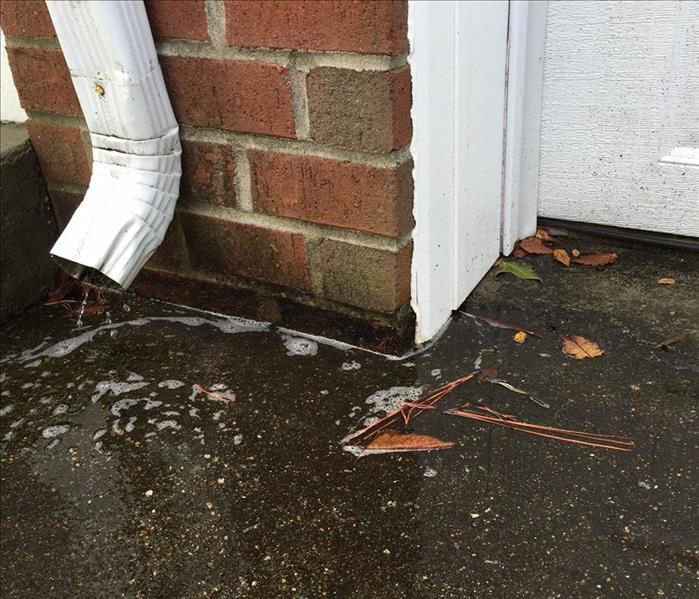 The financial costs of poor drainage can be substantial, and the human health costs significant too.
The financial costs of poor drainage can be substantial, and the human health costs significant too.
Most homes have gutter downspouts that lead straight to the ground, which means all the water from the roof is pouring to just one point where it can collect against a home's foundation. This most often causes the water drainage problems and, thus, the damage.
Prevention is important. Here are some clues that you may have a problem with your gutters:
- Areas where the ground is wet for long periods of time after it rains or the sprinklers are running signal an area where the water is collecting
- Discoloration and mold growth on a home's foundation and siding or paint is easily falling off your house are indications that water is pooling.
- Musty smells in your basement or crawlspace signal water may be getting into your home.
Financial costs of poor water drainage can add up, but the good news is that gutter problems are an easy fix.
Do you have water damage in your home or business ? Call SERVPRO of Northern Summit County's 24/7 Emergency Service line at 330-650-4486 or request help online at our franchise website.
Frozen and Burst Pipes- Understand and Take Precaution
12/27/2017 (Permalink)
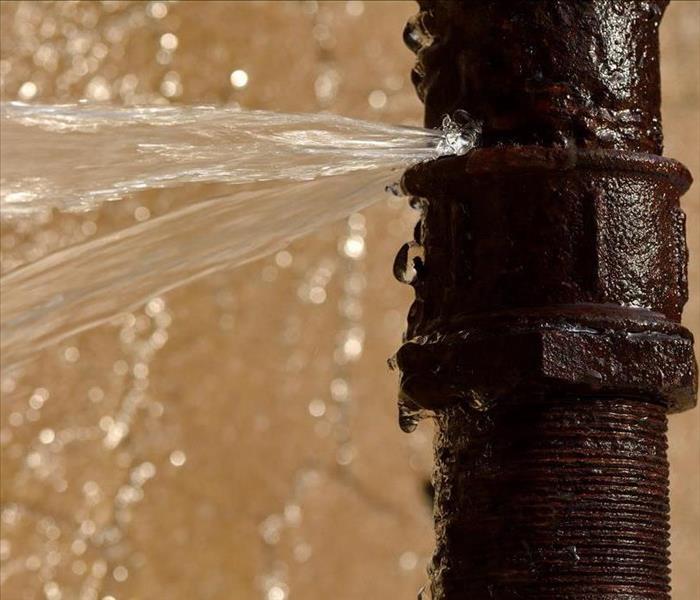 "Even a small crack in a burst pipe can spew hundreds or even thousands of gallons of water in a day."
"Even a small crack in a burst pipe can spew hundreds or even thousands of gallons of water in a day."
If your pipes are exposed to temperatures below 32 degrees Fahrenheit for an extended period of time, the water can freeze and cause extensive damage to your home. This can be avoided!
Frozen pipes can occur for two basic reasons:
- Installation of pipes in an unheated space without adequate protection
- Insufficient heat in the area of the freeze
What types of pipes are susceptible this situation? Domestic water piping, HVAC heating and cooling piping and sprinkler piping are all vulnerable if left in cold and unprotected conditions as stated above. Plastic and metal pipes can burst when they freeze, and depending on the size of the pipe, even a small crack in a burst pipe can spew hundreds or even thousands of gallons of water in a day.
Why does a pipe burst, anyway? Well, when water freezes, it expands. The ice expansion will exert pressure against the pipe wall but also pressurizes the water trapped between the ice and a closed valve or fixture. As the water continues to freeze and expand inside the pipe, it causes the trapped water to continue to increase in pressure, thus, just as a can of soda will burst in your freezer, so does your water pipe.
Some common locations where pipes will freeze are outdoor hose bibs, swimming pool supply lines, fire sprinkler lines and water supply pipes in unheated interior areas. These areas include basements, crawlspaces, attics, garages, bathroom sink cabinets and kitchen cabinets. Pipes along exterior walls that have little or no insulation, voids in the insulation or improperly installed building wrap are subject to freezing. You might want to check in on that sooner rather than later. Review the International Plumbing Code by clicking here.
On what you, the homeowner, can do to prevent a pipe burst from happening, refer back to our blog piece, "How to Thaw a Frozen Pipe."
Remember, this stressful situation can be avoided if you think ahead!
With any questions or if your home has been water-damaged, call SERVPRO of Northern Summit County on our 24/7 Emergency Service line, 330-650-4486 or Request Help Online.
How to Thaw a Frozen Pipe
11/14/2017 (Permalink)
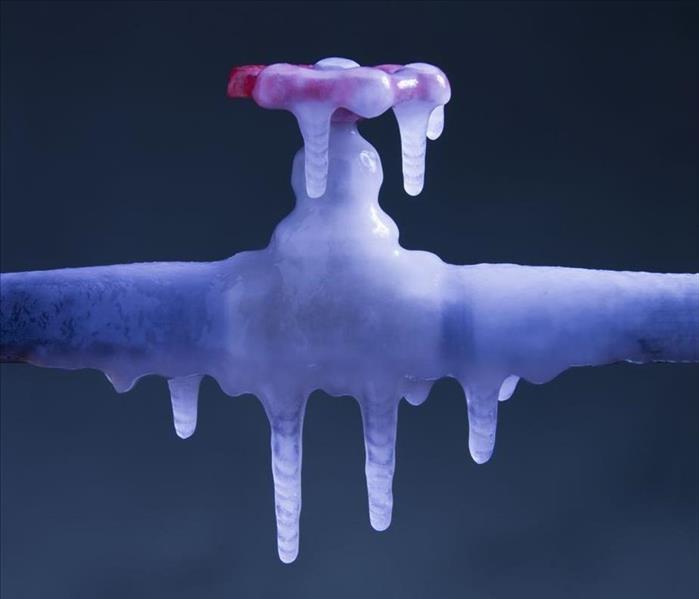 A frozen pipe can exert pressure at over 2,000 Lbs/ square inch, enough pressure to rupture almost any pipe filled with water.
A frozen pipe can exert pressure at over 2,000 Lbs/ square inch, enough pressure to rupture almost any pipe filled with water.
Frozen water pipes are a serious risk during very cold winter weather. When water freezes in a pipe it expands and can exert pressure at over 2,000 pounds per square inch. This pressure is enough to rupture almost any pipe filled with water, which provides no place for the ice to expand. A burst pipe can spill several hundred gallons of water per hour, and that equates to thousands of dollars of damage to your home. Pipes are most susceptible to freezing when they are located:
- in an outside wall
- in a cabinet under a sink (especially near an outside wall)
- in an unheated crawl space or basement
If your pipe is frozen but not yet ruptured, you must thaw it right away. There are a few thawing techniques to try, depending on where the frozen pipe is located.
Warning: Never use a blow torch or other open flame to thaw a pipe. This presents a serious fire hazard and can damage the pipe.
A frozen pipe that hasn't burst yet often reveals itself at a faucet: when you turn on the faucet and no water comes out or it has slowed to a trickle, there's probably a blockage of ice somewhere in the line. It's time take immediate action:
- Shut off the water to the faucet locally or at the home's main water shutoff valve.
- Open the faucet that is supplied by the frozen pipe; do this even if you don't know where the blockage is.
- Identify the frozen pipe and locate the blockage: Follow the pipe back from the faucet to where it runs through cold areas, such as an exterior wall or unheated crawl space. Look for areas on the pipe that have frost or ice; it may also be slightly bulged or fissured.
When you find that the frozen—but not yet burst—pipe is behind a wall or ceiling, you've got a challenge on your hands. You have three options for thawing the pipe:
- Turn up the heat in the house and wait.
- Cut out a section of the wall or ceiling to access the frozen section of pipe, then thaw the pipe as an exposed pipe (see next slide).
- Use an infrared lamp to help heat the wall section in front of where you believe the pipe is frozen. Infrared lamps are better than regular heat lamps because they pass through the air without heating it and will direct more energy to warming the wall and frozen pipe.
If the frozen pipe is exposed, you have several options for thawing it. Whichever remedy use use, heat the pipe from the faucet toward the frozen area. This allows water to flow out as the ice melts.
- Hair dryer: Usually the easiest and safest way to thaw a pipe. If the pipe is close to the wall, place a cookie sheet behind the pipe to help radiate heat onto the backside of the pipe.
- Heat lamp: You can use an infrared or incandescent heat lamp. As with a hair dryer, if the pipe is close to the wall, use a cookie sheet behind the pipe to help reflect heat onto the pipe.
- Portable heater: A small, powerful heater works great for warming pipes under a kitchen or vanity base cabinet. Direct the heater onto the frozen section of pipe. It will work like a hair dryer on steroids!
- Electric pipe heat tape: Heat tape is a ribbon-like wrap that contains electrical heating elements. You wrap it around the pipe you want to heat and plug it into the wall. The temperature of the tape is controlled with a thermostat. Heat tape can also be used to prevent pipes from freezing in critical areas; you can leave the heat tape on the pipe and plug it in only when needed.
There are a few things you can do to prevent the problem of freezing pipes from occurring again:
- Leave the faucet dripping slightly during the coldest time of the day or night.
- Open the cabinet doors to allow the heated air from the room to reach pipes inside the cabinet.
- Wrap the problem pipe with electrical heat tape.
- Insulate problem pipes with foam insulation wrap, especially those that run through unheated spaces. Note: Insulation merely slows the transfer of heat and will not prevent a pipe from freezing if the surrounding air is cold enough.
- Heat unheated areas with a permanent heater, just to keep the temperature above freezing, or about 40 degrees F. Warning: Do not use portable heaters, which should never be left running unattended.
- Remove garden hoses attached to outdoor faucets (hose bibs or sill cocks). If the faucet is not a frost-proof type, turn off the water to the faucet inside the house and drain the exterior section of the pipe and faucet.
Preparing Your Home for Winter Weather- Avoid Water Damage
10/31/2017 (Permalink)
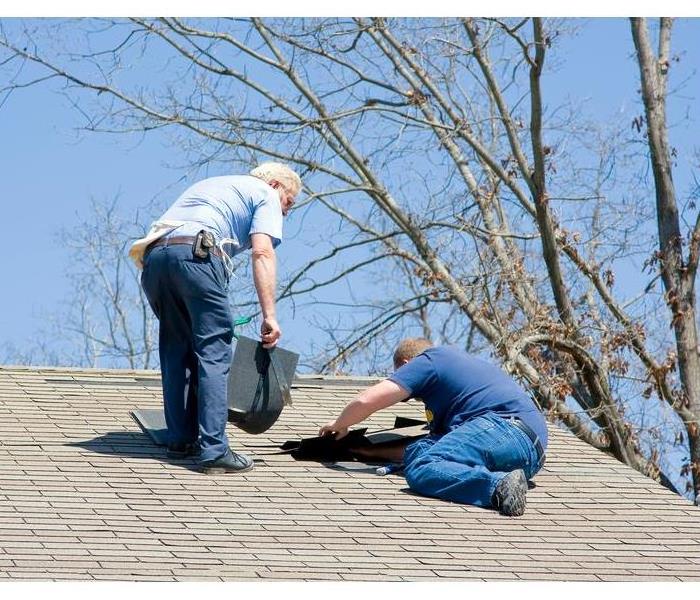 Inspect your roof and gutters on a regular basis — at least twice a year.
Inspect your roof and gutters on a regular basis — at least twice a year.
With winter on the way, we’re heading into a busy time of year that includes several major holidays coming back-to-back. The last thing we want to worry about is the risk of water damage due to the changing weather.
Here are some wintertime considerations to keep your home safe and reduce, or even prevent, possible insurance risks:
- Keep your drains and gutters clean. Exactly how frequently depends on where you live, but you want to plan for twice a year. Clogged gutters can cause a few issues including roof leaks. If your gutters can't drain properly, the excess water can soak through the shingles and eventually start leaking into your home. Don't forget melting snow can also fill up the gutters, causing similar issues!
- Inspect your roof for damage and leaks. While you're cleaning those gutters, take the time to inspect your roof. Keep an eye our for cracks, leaks where different parts of the roof meet, and general wear and tear. You should do this also twice a year at least.
- Water expands, its mass increasing by about 9% when it freezes. Blocked pipes result in a buildup of pressure, which can cause a burst pipe, equipment malfunction, or contaminated water back-up inside the building. To avoid this, consider insulating your water lines and using heat tape as well.
- For extreme weather, it is wise to always leave a tap running at a trickle because running water is less likely to freeze.
Watch for our next blog post on how to defrost a frozen water pipe.
The Truth About 100-Year Floods
10/17/2017 (Permalink)
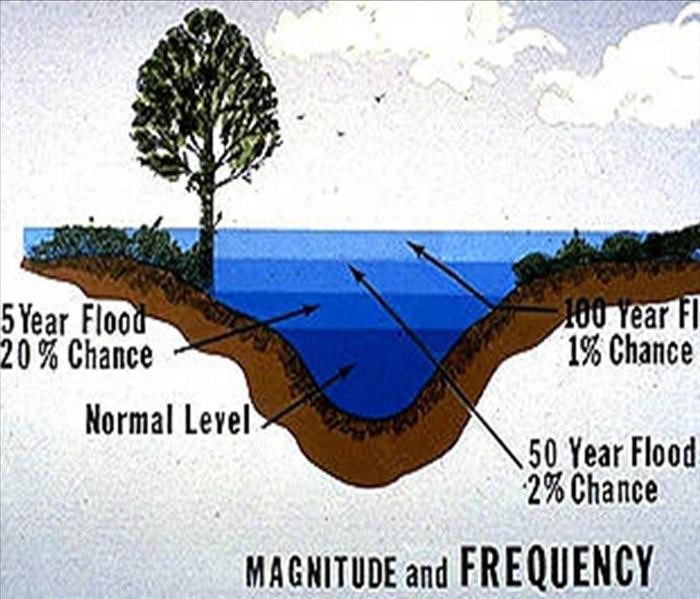 The above image includes a diagram demonstrating the magnitude and frequency of water levels during a flood.
The above image includes a diagram demonstrating the magnitude and frequency of water levels during a flood.
Whenever a strong hurricane or storm causes significant flooding, there is often talk of a 100-year flood. People will think a flood of that magnitude occurs once every hundred years, so they should be safe from harm for the next hundred years. Some base their decision to buy flood insurance on this false belief, putting them at risk of a catastrophic loss.
In order to determine the true frequency of floods, scientists will create a history of the area, tracking the frequency of different sized floods and the average number of years between them to develop the probability of a given sized flood in a particular year.
But rain volume alone does not always create the flood. The condition of the ground before the rain is critically important. If the area has received a lot of rain recently and the ground is already saturated, less rain is needed to flood the area. If the area has been experiencing a drought and the rain is falling fast, it is possible for the water to run off instead of soaking into the ground.
Factors such as a river basin and the addition of dams and levees will be considered. Once a flood recedes, high-water marks will be surveyed by scientists to estimate the maximum flows and streamgages will record the height and quantity of flow.
Explained by Property Casualty 360 in their article "The truth about 100-year floods," "The accumulation of data allows for a determination of the annual probability that a given stream or river will exceed its banks. This is known as annual exceedance probability, or AEP. A 1% AEP flood has a 1 in 100 chance of occurring every year, with an average recurrence every 100 years. This is the 100-year flood." They also predict during a span of a 30-year mortgage, "there is a 26% chance of a home in a 1% AEP, or 100-year flood area, of being flooded."
Questions about flood damage? Call SERVPRO of Northern Summit County today at- 330-650-4486.
Water Back-Up, Overflow or Discharge? Homeowners' Claims
8/22/2017 (Permalink)
Last month we talked about how to protect your home from flood damage. Hopefully the tips served you well, but here are some tips on what causes a water back-up or overflow and whether or not there is coverage for such a loss.
Is it a water back-up, an overflow or discharge?
A back-up is a build-up caused by a stoppage in the flow. Something prevents the water from continuing down its path, so it is forced to reverse direction and go back the other way.
- Causes: A collapsed drain pipe can cause a back-up because water can no longer proceed down its normal course. A blockage can also cause a back-up. The blockage prevents the water from going forward. Both of these factors force the water to reverse direction.
An overflow is when excess or surplus is not able to be accommodated by an available space.
- Causes: The space is filled to capacity and water then spreads beyond its limits. A bath tub left running creates an overflow, as well.
Discharge is what happens when water is released from plumbing or appliances and then floods your home.
- A leaking pipe discharges water from the hole in the pipe.
The ISO HO 00 03 provides coverage for water damage that is the result of a discharge or overflow of a plumbing, heating, air conditioning, or household appliance if it is on the resident’s premises. This covers:
- Pipes that leak behind walls
- Floors, or ceilings
- Washing machines and dishwashers that overflow
- Toilets that overflow
- Storm drains off premises that overflow due to high rains or floods
It is important to note that a sump, sump pump or related equipment, or a roof drain, gutter or downspout or similar equipment is not considered a plumbing system or household appliance.
A discharge or overflow caused by a storm drain, water, steam, or sewer pipe is covered as well if it is off the premises.
6 Ways to Protect Your Home From Flooding
7/21/2017 (Permalink)
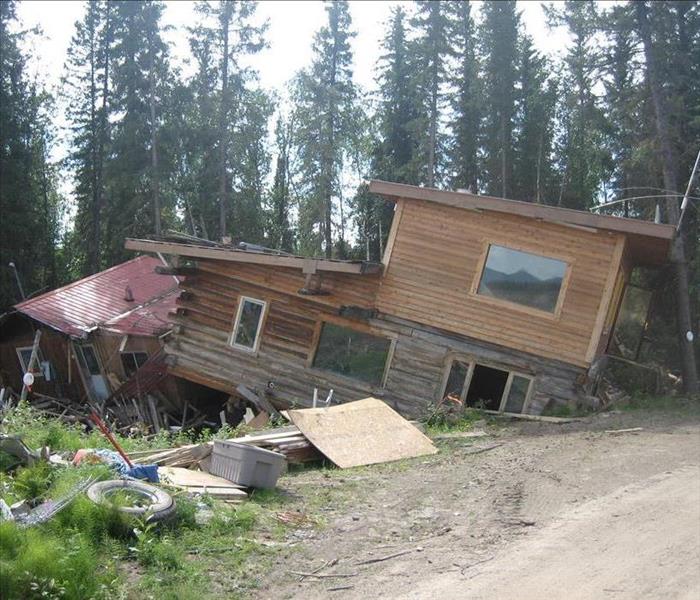 The erosive force of moving water can drag dirt from under a building's foundation, causing it to crack and tumble.
The erosive force of moving water can drag dirt from under a building's foundation, causing it to crack and tumble.
Flooding can strike anywhere and at any time, and floods are the most common and most expensive natural disaster in the U.S. Ignoring the risk means a destroyed home and belongings, and mold soon follows that.
Your first step in avoiding this risk is knowing the flood level of the home you're buying- an official measure of how high floodwaters could rise. You can find this information at FEMA's online flood maps.
Your next steps in protecting your home from flooding should include these 6 measures:
- Safeguard in-home electrical and climate systems. Raise switches, sockets, circuit breakers and wiring at least a foot above the expected flood level in your area. Modify your furnace, water heater, and any other anchored indoor equipment.
- Anchor and raise outdoor equipment. Fuel tanks, air-conditioning units and generators should be anchored above your flood level. Unanchored fuel tanks can break free, and severed supply lines will contaminate surrounding ground.
- Modify water valves. A flooded sewer system can cause sewage to back up in your home. Install an interior or exterior backflow valve.
- Determine how water flows around your house. The grading or slope of the house, the angle of the ground, can direct water to or away from your house. This is easy to determine by watching how water flows or accumulates during an average rainstorm.
- Opt for a major retrofit. If your home floods frequently and moving isn't an option, you may need to take drastic and costly measures. Either raise your home on piers or columns so the lowest floor is above flood level, wet-proof your home by installing foundation vents that would allow water to flow through the building instead of rising inside, or do some dry-proofing by applying coatings and other sealing materials to your walls to keep our floods.
- Take last-minute measures as waters rise. Clear gutters, drains and downspouts. Move furniture, rugs, electronics and other belongings to upper floors. Shut off electricity at the breaker panel. Elevate major appliances onto concrete blocks if they're in harm's way.
If you have any flood damage in your home or building, call us today at our 24/7 Emergency Service Line - (330) 650-4486 or at our Online Help Line.
Are You in Need of a Water Heater Repair?
6/15/2017 (Permalink)
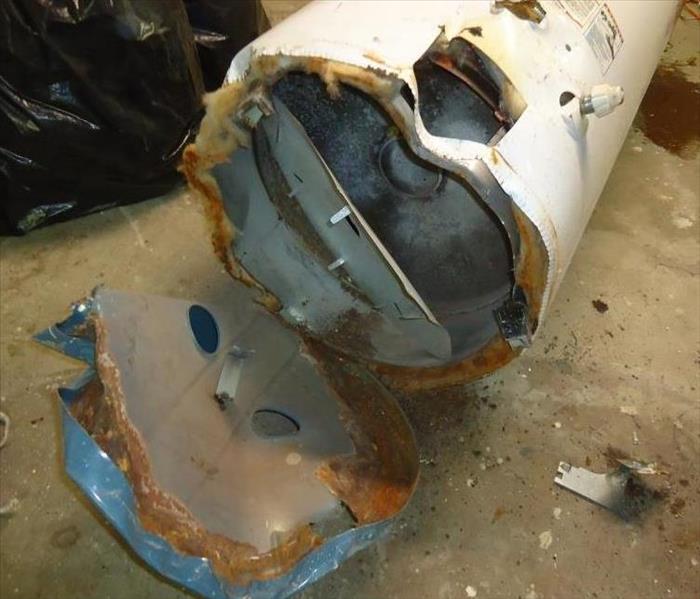 A corroded water heater will occur if not maintained, leading to flooding and further damage
A corroded water heater will occur if not maintained, leading to flooding and further damage
It's easy to forget our water heaters need to be maintained- we use them frequently for showers, the dishwasher and the washing machine. But if we neglect the maintenance could result in malfunctions and replacing the water heater.
Notice these first signs to avoid a bigger problem:
- The smell and color
- The hot water will have an off smell and rusty color.
- This could be the result of a rusty anode rod in the water heater, and the anode rod can be replaced.
- The smell could be due to bacteria growth. This happens when the hot water has not been used or has been turned off for some time.
- The corroded pipes
- Cause an off-color, water that is not hot enough, too hot or no water at all, as well as sediments appearing in the water
- Before acting on the above points, have the water heater inspected by a plumber
- Can be solved by installing a water softener or by replacing the plumbing
- The strange noises and leaks
- Usually caused by a buildup of sediments inside the tank
- Leaks coming from the water heater could lead to flooding
- Pops, bangs, gurgles and the like indicate something is wrong with the water heater
- A boiling sound indicates the water heater is overheating or pressure is building up inside the tank
- All the above need to be addressed immediately to prevent further problems
Having your water heater repaired as soon as you see these signs will save costs, further damage to your unit and home and replacing your unit altogether.
Faster to your Northern Summit County Water Damage Event
10/13/2016 (Permalink)
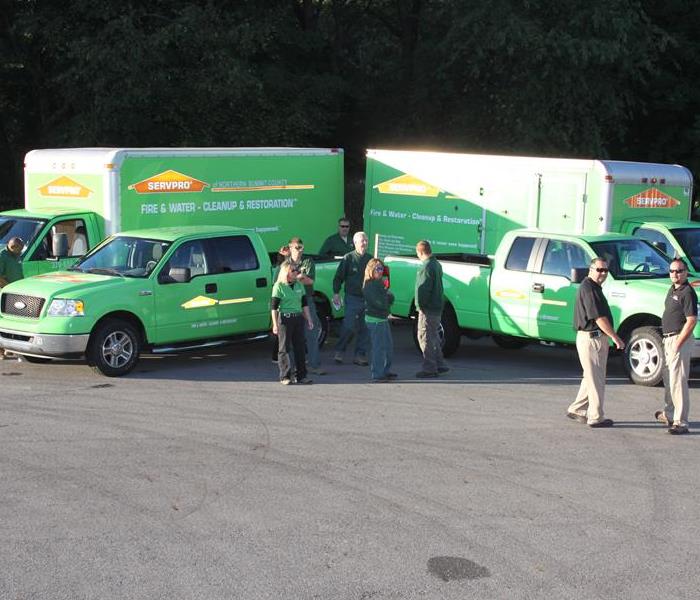 SERVPRO of Northern Summit County provides 24 hour fire and water damage restoration service in Hudson, Twinsburg, Macedonia, & surrounding areas.
SERVPRO of Northern Summit County provides 24 hour fire and water damage restoration service in Hudson, Twinsburg, Macedonia, & surrounding areas.
Flooding and water emergencies don’t wait for regular business hours and neither do we. SERVPRO of Northern Summit County provides emergency cleaning and restoration services 24 hours a day, 7 days a week—including all holidays.
Faster To Any Size Disaster
Flooding and water damage is very invasive. Water quickly spreads throughout your home and gets absorbed into floors, walls, furniture, and more. SERVPRO of Northern Summit County arrives quickly and starts the water extraction process almost immediately. This immediate response helps to minimize the damage and the cleaning and restoration costs.
Need Emergency Service? Call Us 24/7 – 330-650-4486
Water Damage Timeline
Within Minutes
- Water quickly spreads throughout your property, saturating everything in its path.
- Water is absorbed into walls, floors, upholstery, and belongings.
- Furniture finishes may bleed, causing permanent staining on carpets.
- Photographs, books, and other paper goods start to swell and warp.
Hours 1 - 24:
- Drywall begins to swell and break down.
- Metal surfaces begin to tarnish.
- Furniture begins to swell and crack.
- Dyes and inks from cloth and paper goods spread and stain.
- A musty odor appears.
48 Hours to 1 Week:
- Mold and mildew may grow and spread.
- Doors, windows, and studs swell and warp.
- Metal begins to rust and corrode.
- Furniture warps and shows signs of mold.
- Paint begins to blister.
- Wood flooring swells and warps.
- Serious biohazard contamination is possible.
More Than 1 Week:
- Restoration time and cost increase dramatically; replacing contaminated materials and structural rebuilding may be extensive.
- Structural safety, mold growth, and biohazard contaminants pose serious risks to occupants.
About SERVPRO of Northern Summit County
SERVPRO of Northern Summit County specializes in the cleanup and restoration of residential and commercial property after a fire, smoke or water damage event. Our staff is highly trained in property damage restoration. From initial and ongoing training at SERVPRO’s corporate training facility to regular IICRC-industry certification, rest assured our staff is equipped with the knowledge to restore your property.
Frozen Pipe Bursts Part 3: What to do if a Frozen Pipe Bursts
2/2/2016 (Permalink)
 Damage resulting from a pipe burst due to a frozen pipe
Damage resulting from a pipe burst due to a frozen pipe
Taking preventative measures and noticing frozen pipes in time to thaw blockages are key to avoiding pipe bursts. Unfortunately, sometimes disasters occur despite our best efforts at prevention. In the unfortunate event that a frozen pipe does burst, you can mitigate the damage by following these important tips:
- Turn off the main water supply immediately.
- If the water is flowing near any electrical outlets or conductors of electricity, you should also shut off the electricity.
- Contact a plumber to repair the burst pipe.
- Remove the water. Use buckets, towels, and a wet/dry vacuum to remove water from the affected area.
- Act quickly! The longer there are wet materials in your home, the greater chance there is for mold, warping, and more serious damage.
- If you feel that the water damage is too much for you to handle on your own or you would like assistance in the cleanup, contact the qualified water mitigation specialists at SERVPRO to assist you.
If you or someone you know is faced with a pipe burst, the experts at SERVPRO can help to mitigate the damage and restore your home!
Sources:
http://www.policyexpert.co.uk/insurance-blog/house-home/pipes-burst-freeze/
https://www.washingtonpost.com/local/what-to-do-if-a-frozen-pipe-bursts-in-your-home/2015/02/19/af9b87be-b857-11e4-aa05-1ce812b3fdd2_story.html
Frozen Pipe Bursts Part 2: Thawing Frozen Pipes
1/5/2016 (Permalink)
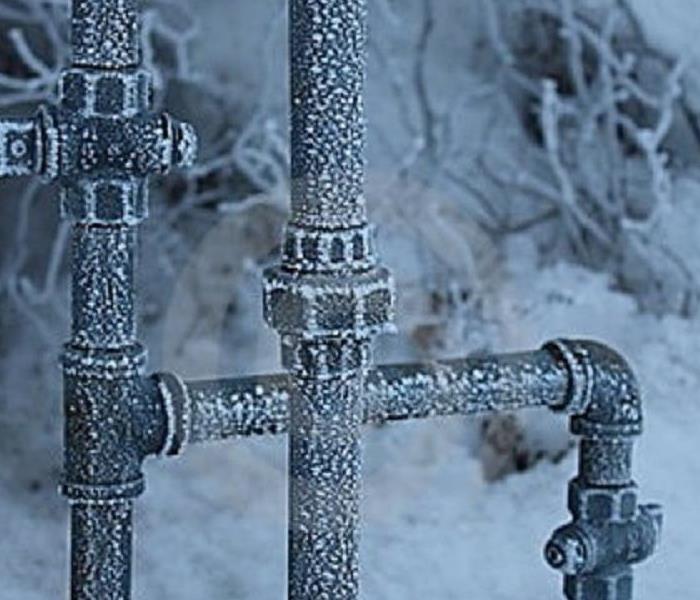 Act quickly if you discover frozen pipes in your home to avoid the damage that pipe bursts can cause.
Act quickly if you discover frozen pipes in your home to avoid the damage that pipe bursts can cause.
Frozen Pipe Bursts Part 2: Thawing Frozen Pipes
In the previous blog post, we discussed how to prevent frozen pipes in order to avoid a pipe burst. If a frozen pipe occurs despite your best efforts at prevention, there are still steps that you can take to thaw the affected pipe before a burst occurs and the situation becomes a much bigger issue. You will notice a pipe may have frozen when after turning on a tap no water or a very small trickle comes out.
- The first thing you should do is turn off the main water supply. If you don’t already know where your main water supply is, locate it now in order to be able to act quickly if you ever find yourself in a situation where your pipes have frozen.
- Locate the frozen pipe by turning on taps one at a time to see if water flows out. If water flows in all areas of the house except for one, trace the line from the blocked faucet to areas that may be more exposed to cold. If water does not flow out of any of the taps, the frozen pipe may be located near the water meter.
- Once you have located the affected area, use a blow dryer, heat lamp, or other heat source to apply heat to the affected area. Do NOT use a blowtorch or any other device with an open flame.
- Keep the faucet open and apply heat from the open tap toward the blockage. Continue to apply heat until the water flows from the faucet at normal pressure.
- If you are struggling to find the blockage or are unsure if the pipe is clearing properly, contact a plumber.
Even during a close call with a frozen pipe, if you follow these steps and put the preventative tips from the previous blog post into action, you can boost your chances of avoiding water damage to your home due to a pipe burst.
Sources:
http://www.oldhouseweb.com/how-to-advice/thawing-frozen-pipes.shtml
http://www.redcross.org/prepare/disaster/winter-storm/preventing-thawing-frozen-pipes
Frozen Pipe Bursts Part 1: Preventing Frozen Pipes during Winter Months
12/15/2015 (Permalink)
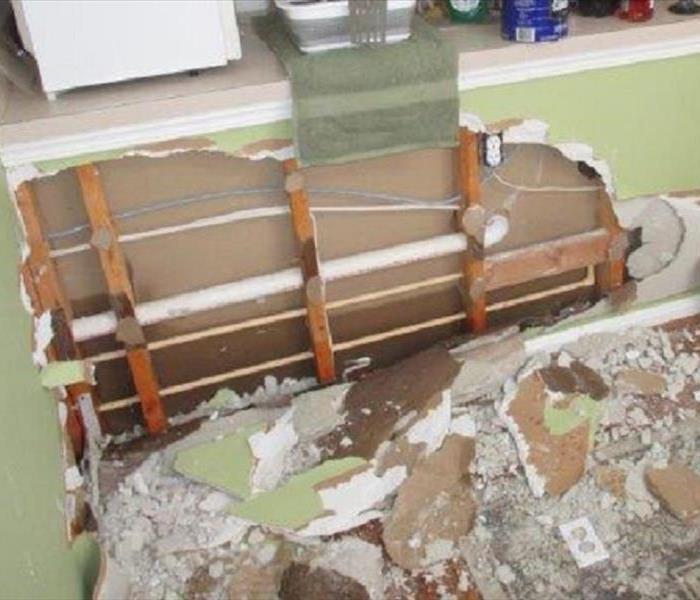 Damage that occurred as a result of a pipe burst due to a frozen pipe.
Damage that occurred as a result of a pipe burst due to a frozen pipe.
Frozen pipes can mean big problems for your home. As water freezes, it expands and can exert up to 2,000 pounds of pressure per square inch! That pressure can cause pipes to burst and water to flow into your home, potentially causing extensive damage.
Taking preventative measures during the cold winter months is the best course of action to avoid frozen pipe bursts. The pipes that are most susceptible to freezing are those that are outdoors, are exposed to exterior walls, or are in unheated areas like under cabinets or in attics or crawl spaces. In order to prevent frozen pipes in those areas, follow these tips:
- Drain water from hoses, water sprinklers, and other outdoor lines when the weather starts to cool down and they will no longer be in use.
- On particularly cold days, open cabinet doors to allow warm air to flow around pipes and turn on the taps slightly to allow a slow drip to run through the faucets.
- Make sure that there is insulation present in areas around pipes that are more susceptible to cold weather.
- Consider installing heating cable, heating tape, newspaper, or another form of insulation around exposed pipes.
- If you are leaving for vacation, don’t set the temperature any lower than 55°F.
Putting these tips into practice will significantly reduce your chances of having a pipe freeze in your home, and thereby, avoid the larger and much more costly and inconvenient problem of a pipe burst.
Sources:
http://homerepair.about.com/od/plumbingrepair/ss/thaw_frzn_pipe.htm#step1
http://www.redcross.org/prepare/disaster/winter-storm/preventing-thawing-frozen-pipes
Do's and Don'ts to follow after a Flood or other Water Loss
9/8/2014 (Permalink)
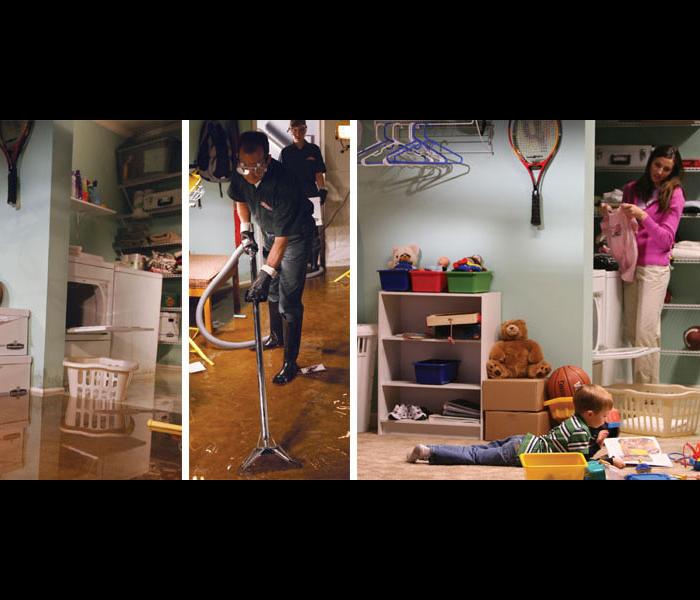 By following these steps before water mitigation begins, you can take great steps to avoid further property damage in your wet basement or other area
By following these steps before water mitigation begins, you can take great steps to avoid further property damage in your wet basement or other area
The period after a large storm or flood is often a hectic and confusing time. While waiting for SERVPRO to arrive to perform water damage or flood cleanup, here are some simple do’s and don’ts to follow until help arrives. By following these steps before water mitigation begins, you can take great steps to avoid further property damage in your wet basement or other areas of your home:
For CLEAN Water Losses
DO
1. Shut off the source of water if possible or contact a qualified party to stop the water source.
2. Turn off circuit breakers for wet areas of the building when access to the power distribution panel is safe from electrical shock.
3. Remove as much excess water as possible by mopping and blotting.
4. Wipe excess water from wood furniture after removing lamps and tabletop items.
5. Remove ad prop up wet upholstery cushions for even drying.
6. Place aluminum foil or wood blocks between furniture legs and wet carpeting.
7. Remove to a safe, dry place any paintings, art objects, computers, documents and other materials that are valuable or sensitive to moisture.
8. Use wooden clothespins to keep furniture skirting off damp floors.
9. Hang draperies with coated hangers to avoid contact with wet carpeting or floors.
10. Hang furs and leather goods to dry separately at room temperature.
DON’T
1. Enter rooms with standing water where electrical hazards may exist.
2. Enter affected areas if electrical outlets, switches, circuit breakers or electrical equipment are exposed to water. Always avoid electrical shock hazards.
3. Leave books, newspapers, magazines or other colored items on wet carpets or floors to cause staining.
4. Leave Oriental rugs or other colored rugs on wet wall-to-wall carpets to cause staining.
5. Use your household vacuum cleaner to remove water, possibly causing electrical shock or damage to the vacuum cleaner.
6. Use TV’s or other appliances while standing on wet carpets or floors, especially not on wet concrete floors.
7. Turn on ceiling fixtures if ceiling is wet or enter rooms where ceilings are sagging from retained water.
Additional Information for CONTAMINATED Water Losses
DO
1. Avoid all contact with sewage and items contaminated by sewage.
2. Wash your hands thoroughly after contact with contaminated items.
DON’T
1. Spread contaminated water by walking unnecessarily on damaged or wet areas.
2. Turn on the HVAC system is there is a possibility of spreading contaminated air.
3. Use household fans to dry the structure and spread contaminants.
4. Use products for personal hygiene and cleanliness if exposed to the contaminated area.






 24/7 Emergency Service
24/7 Emergency Service

